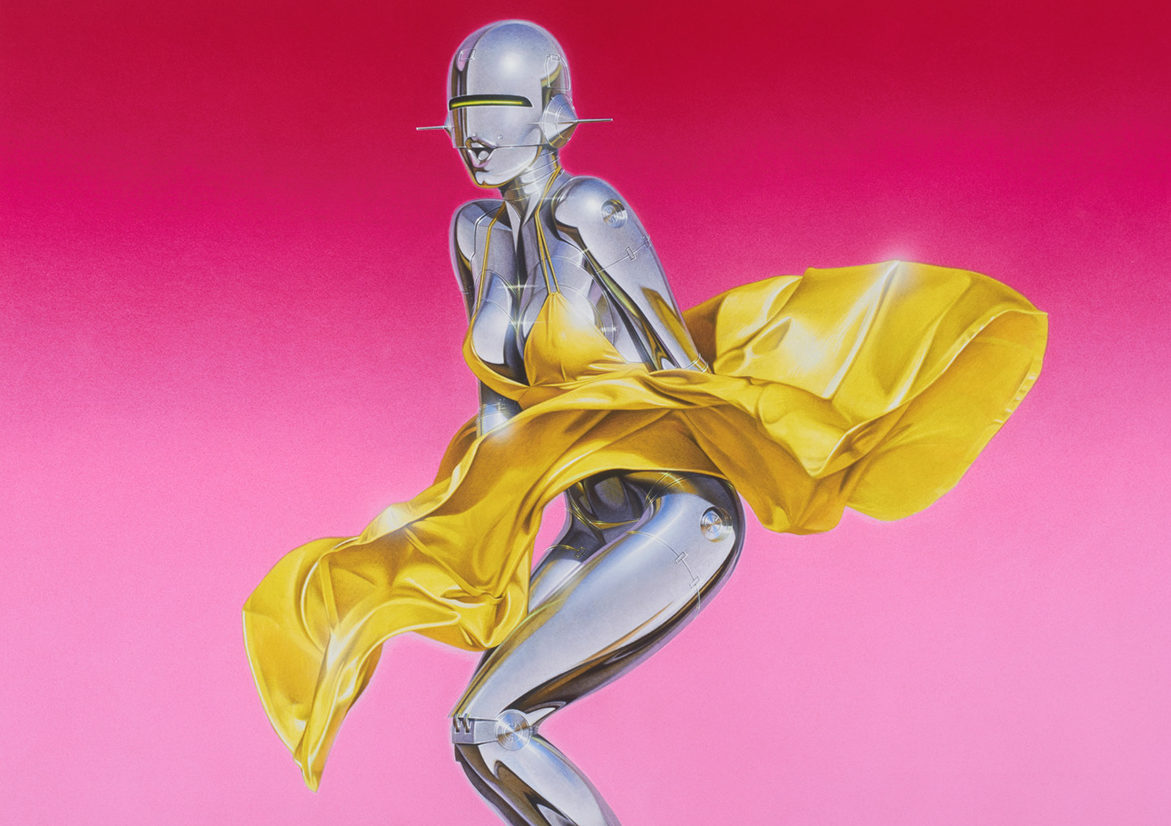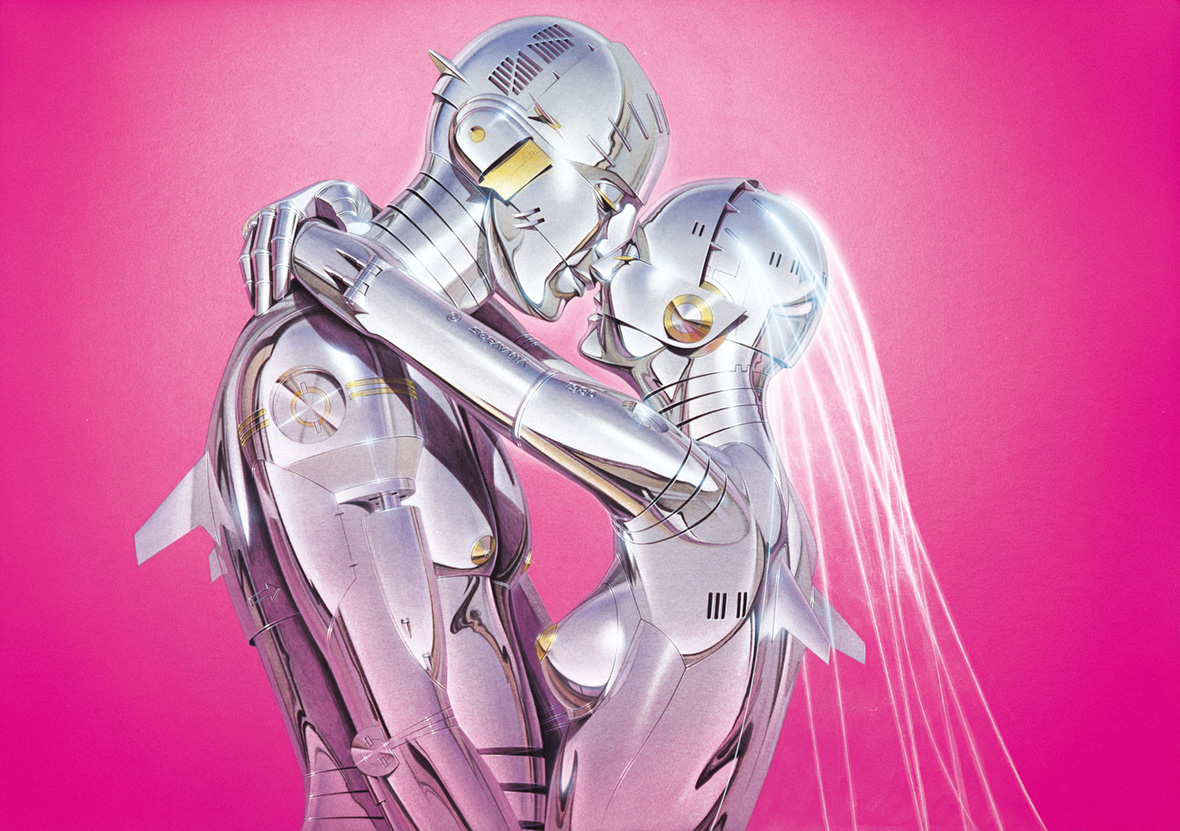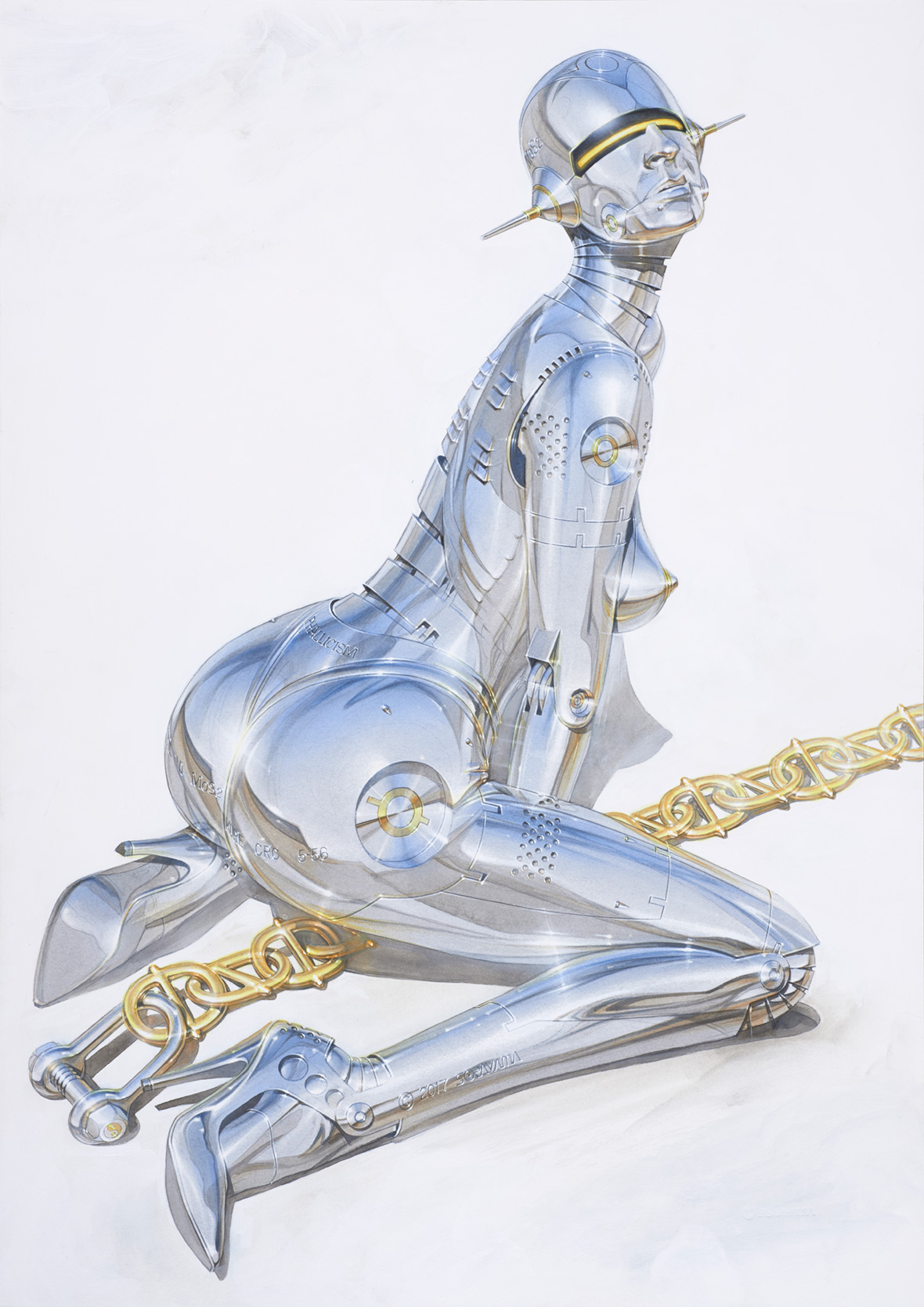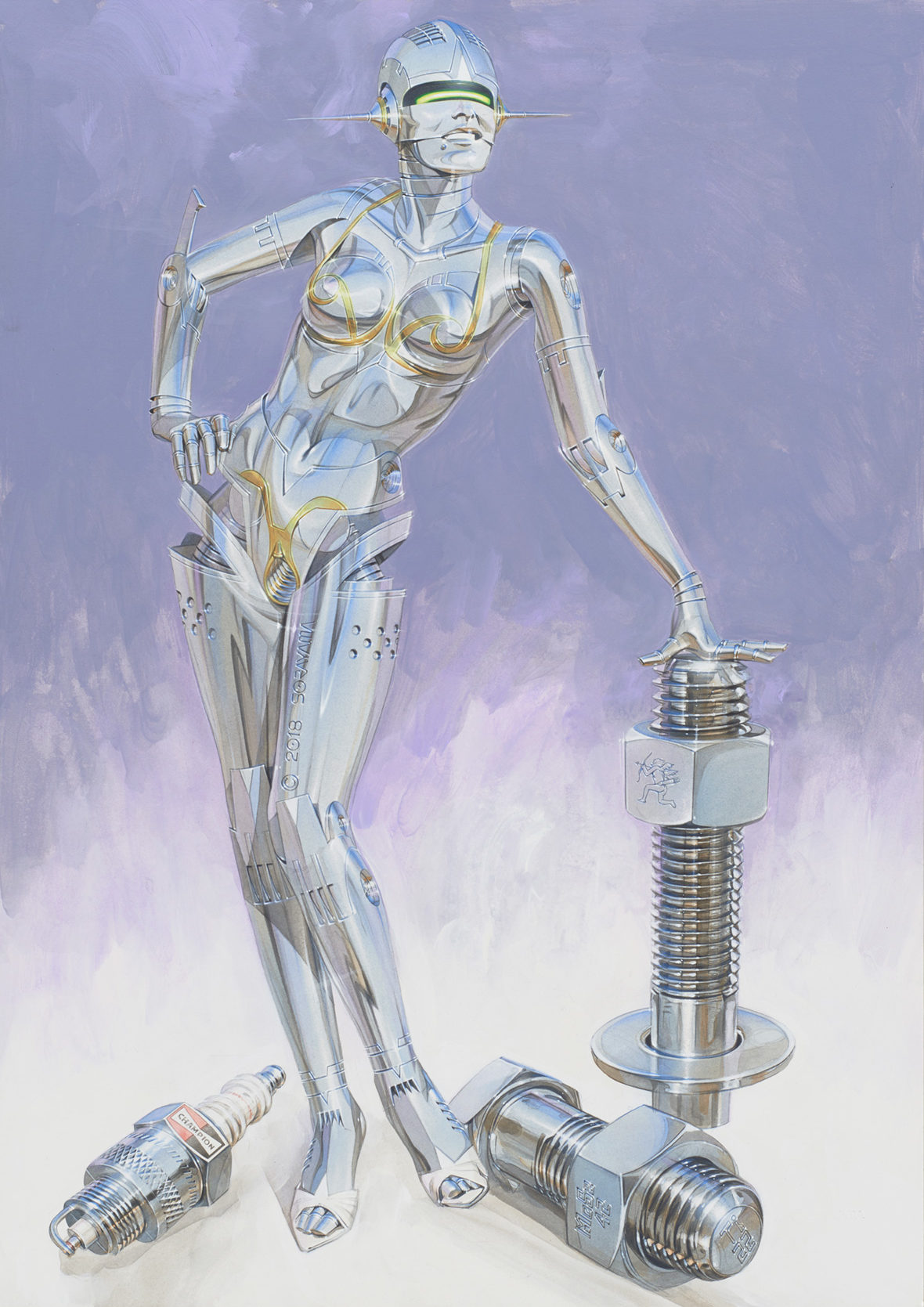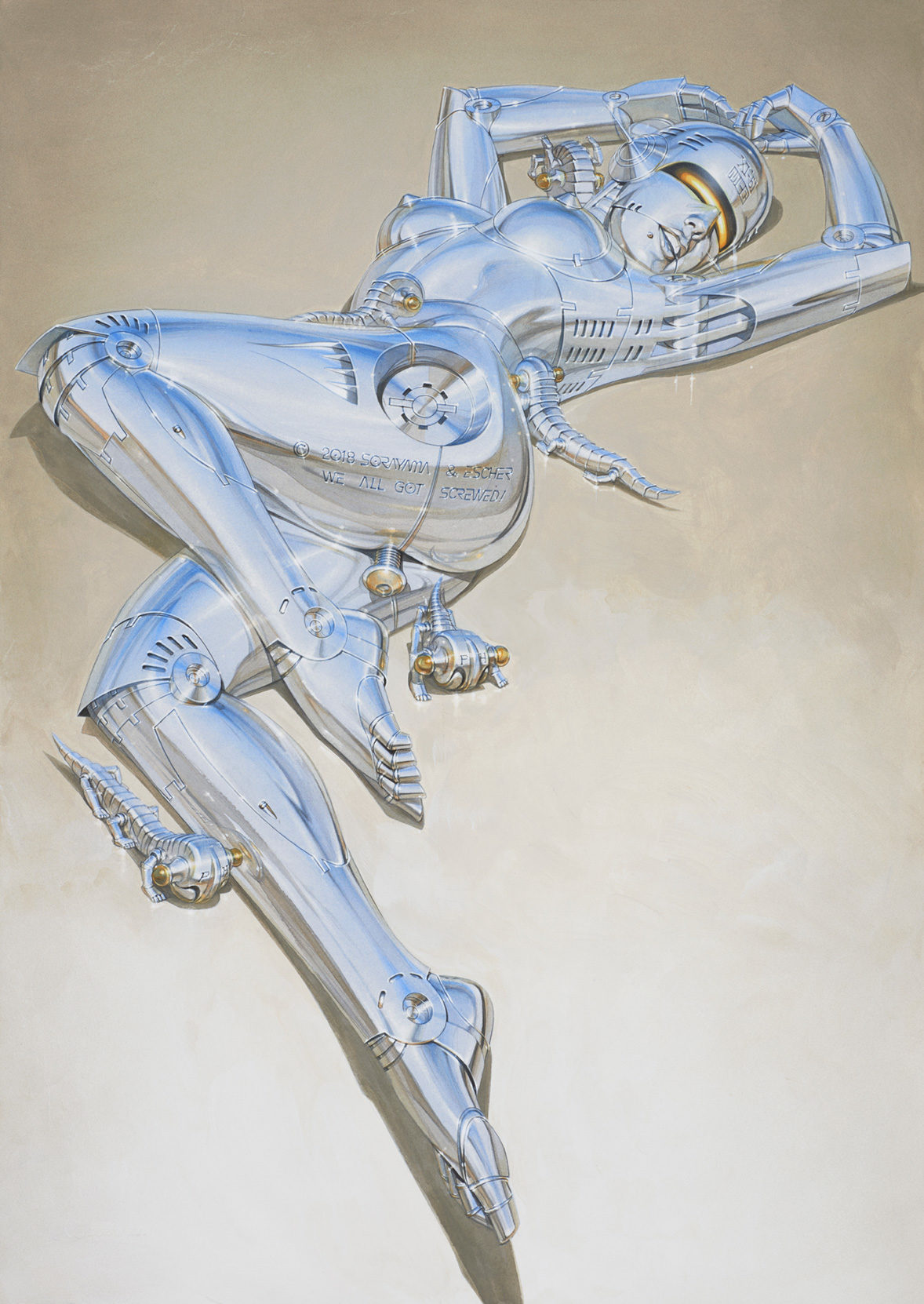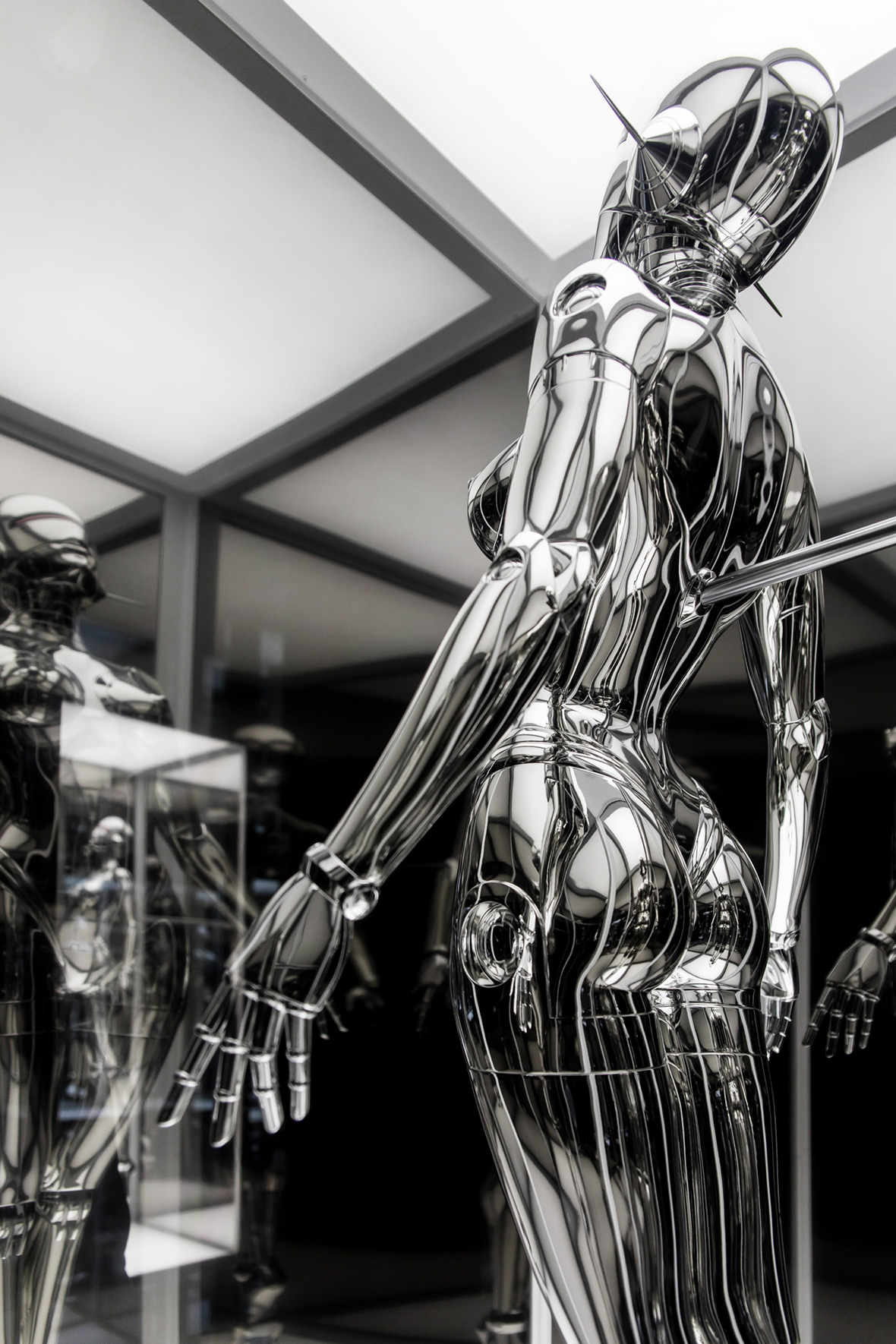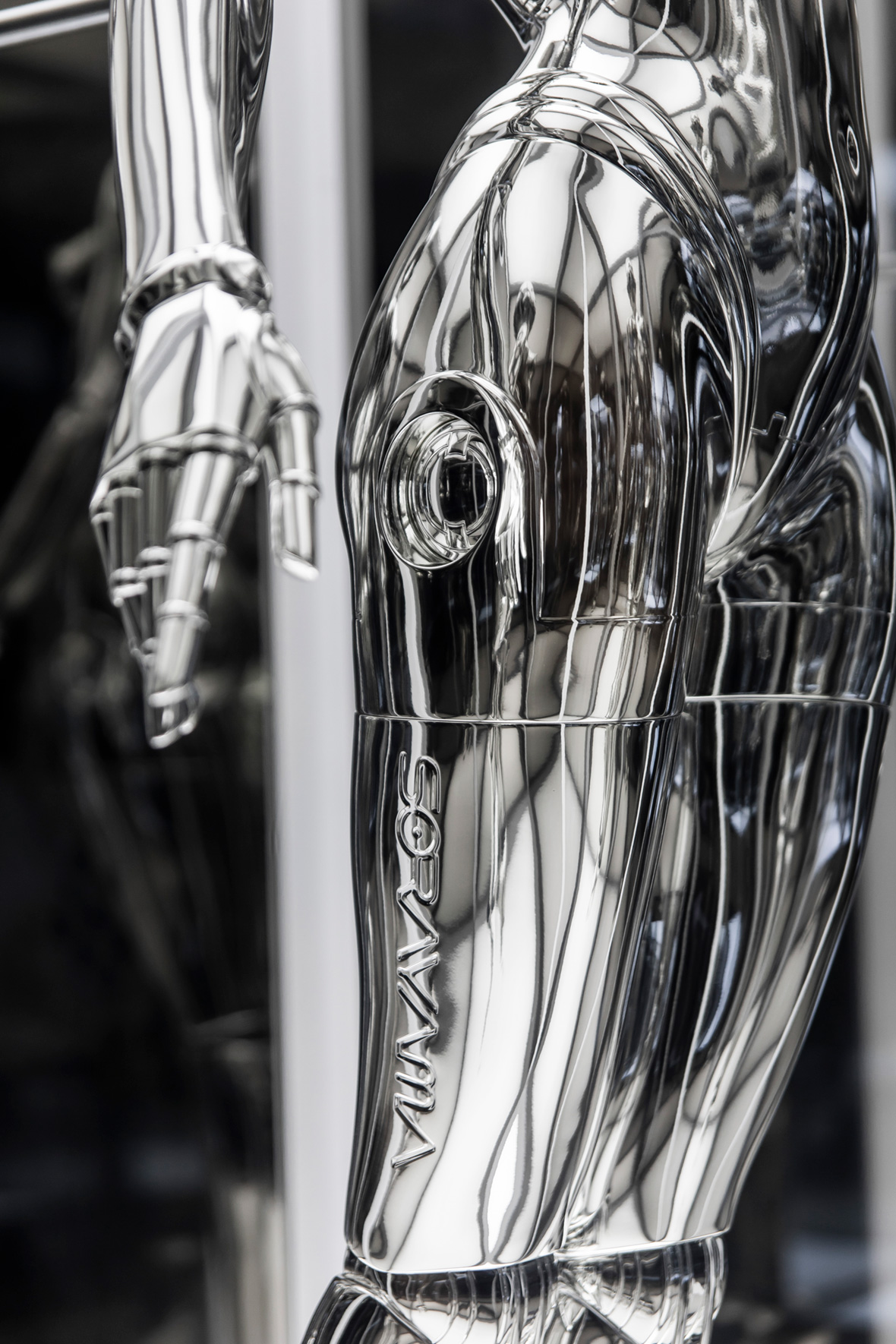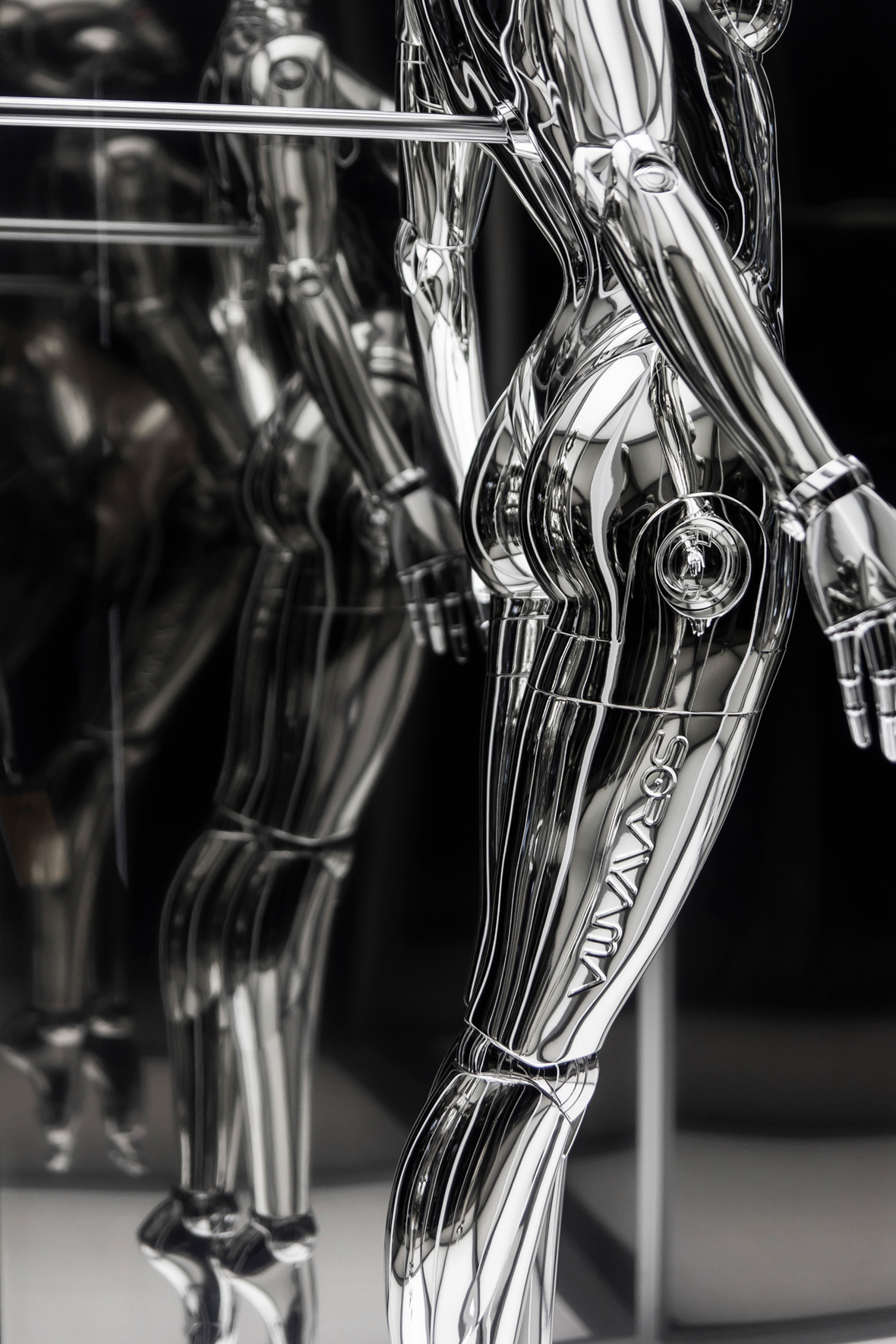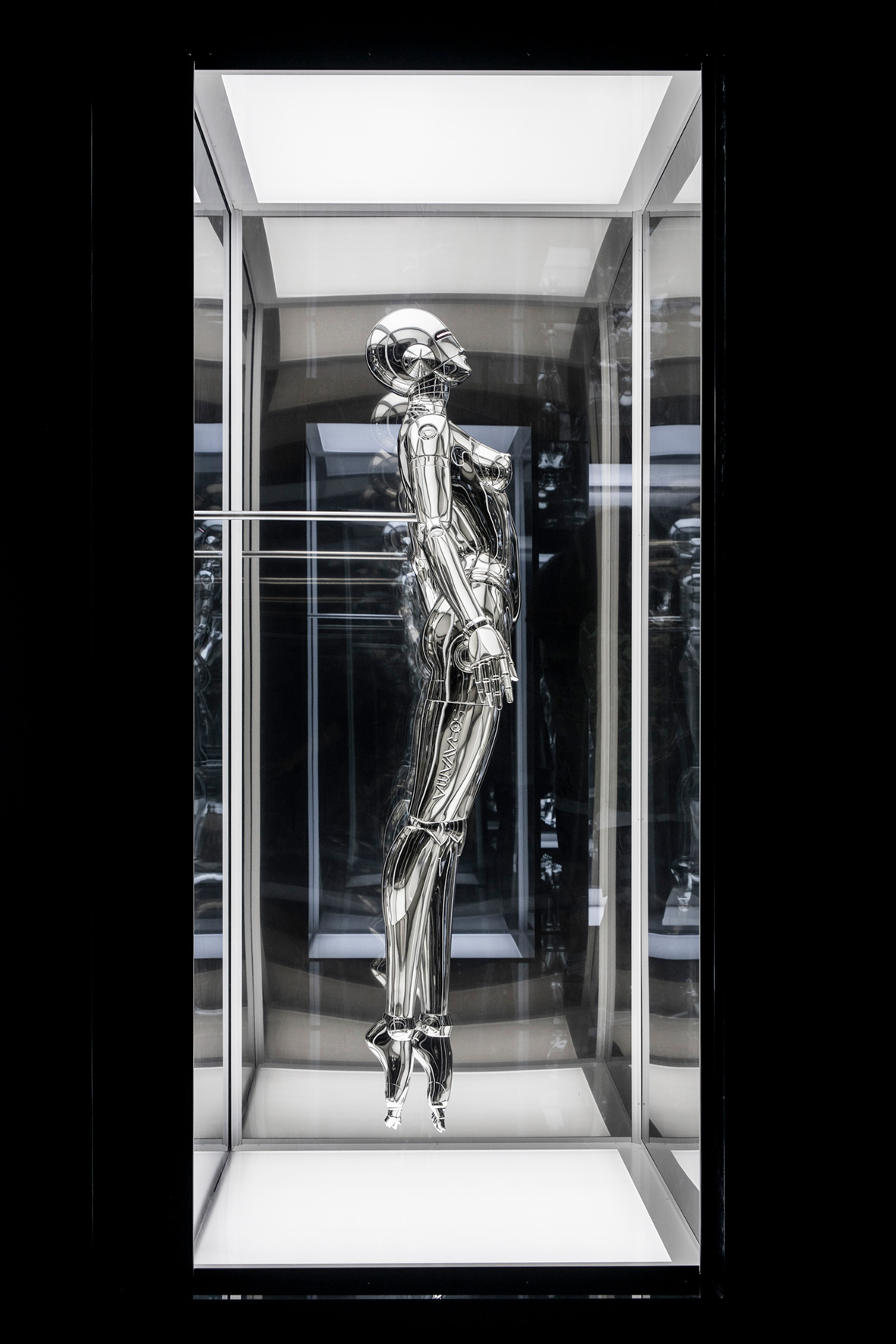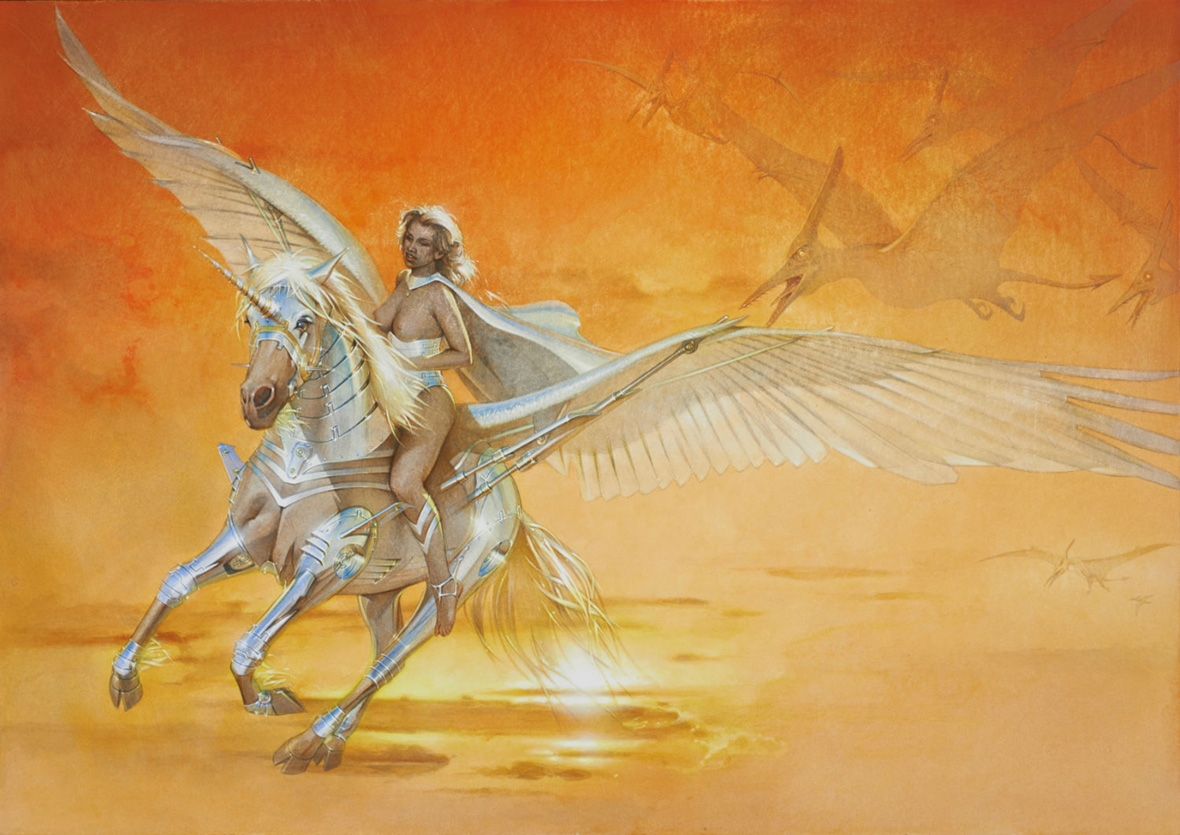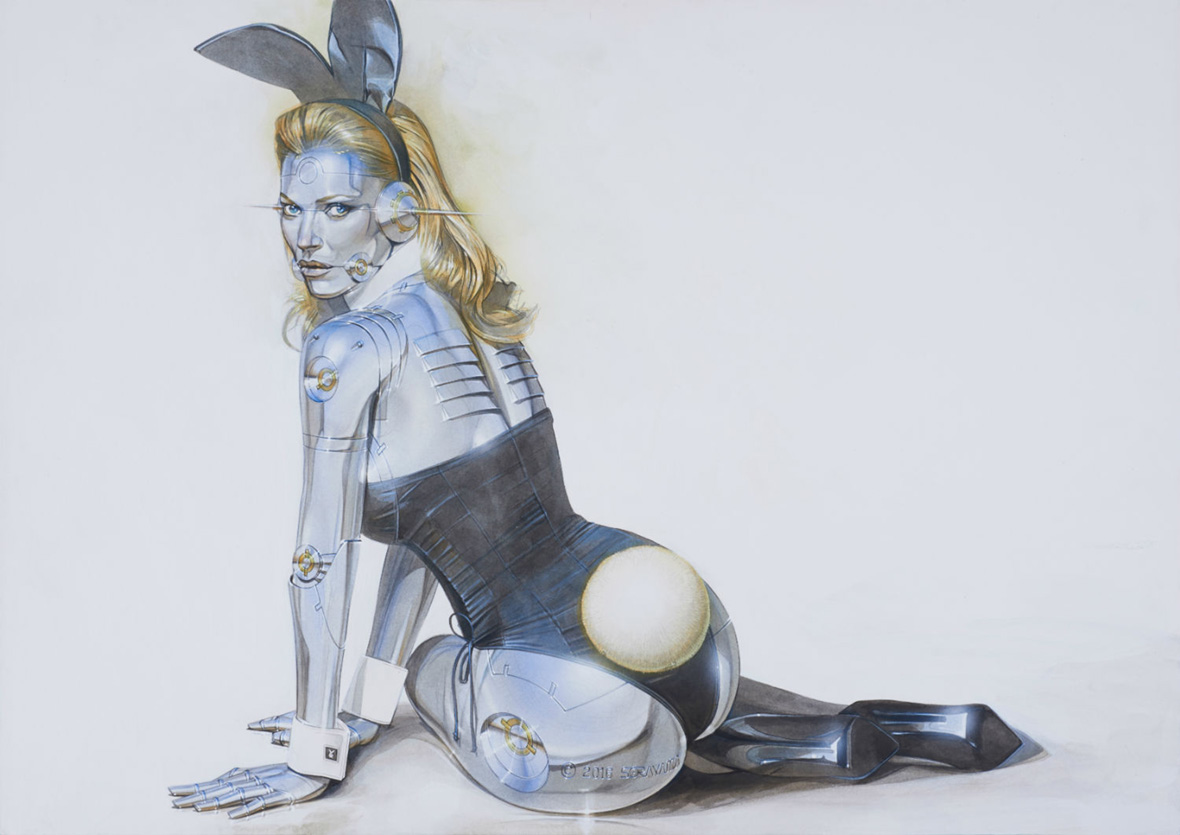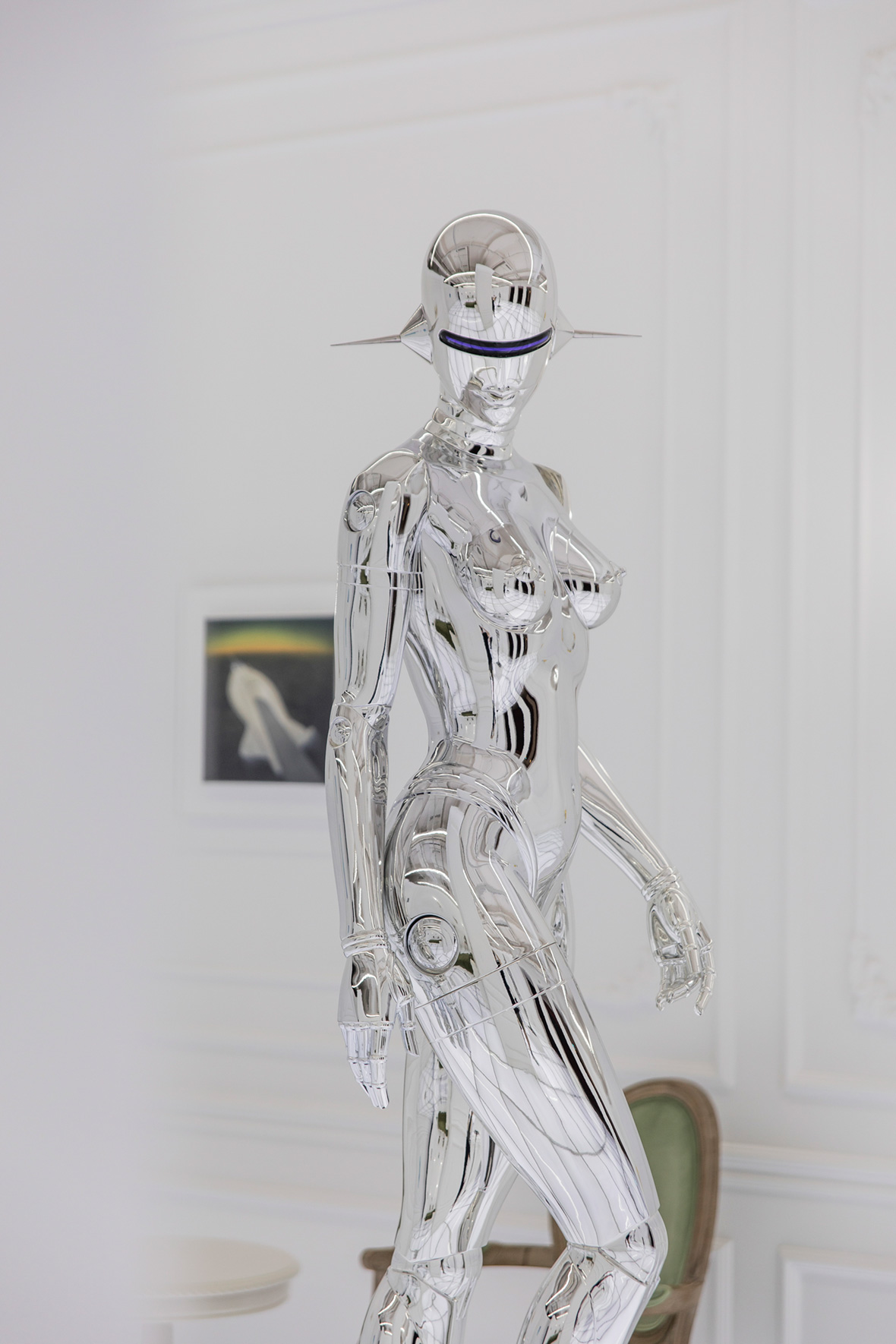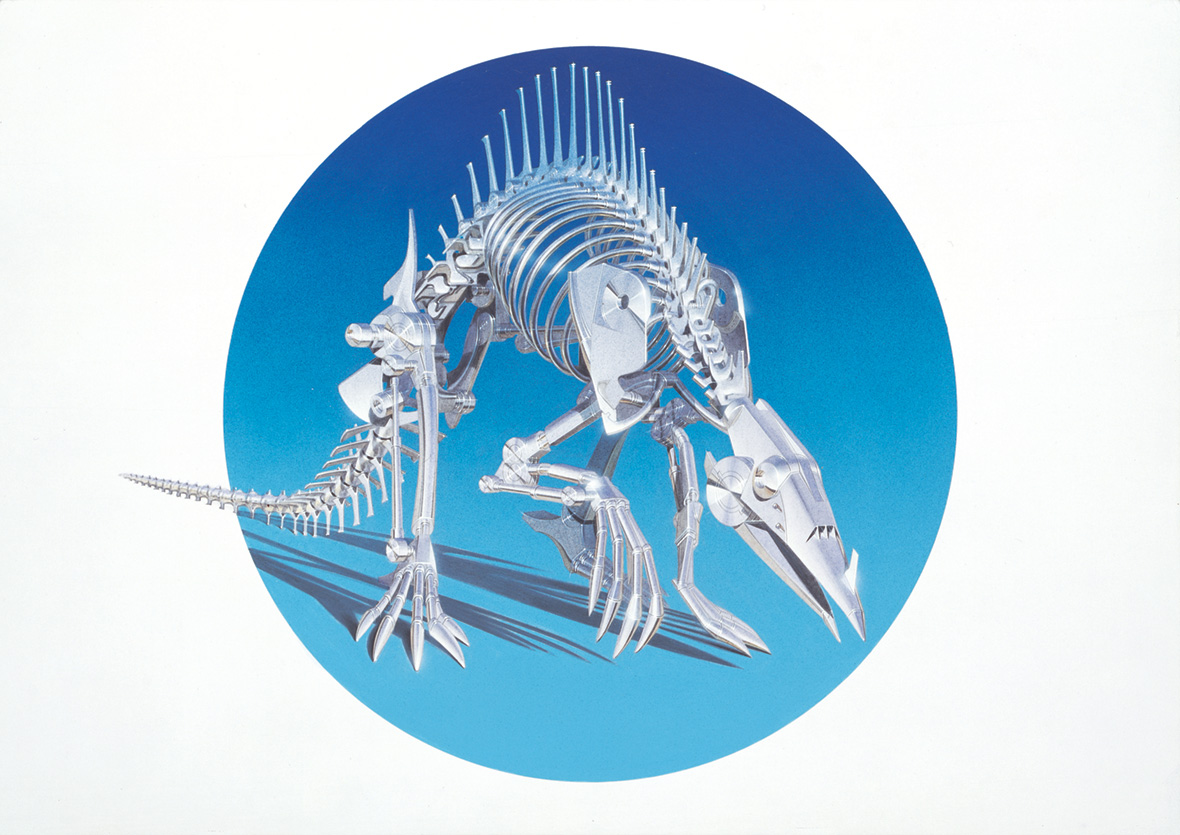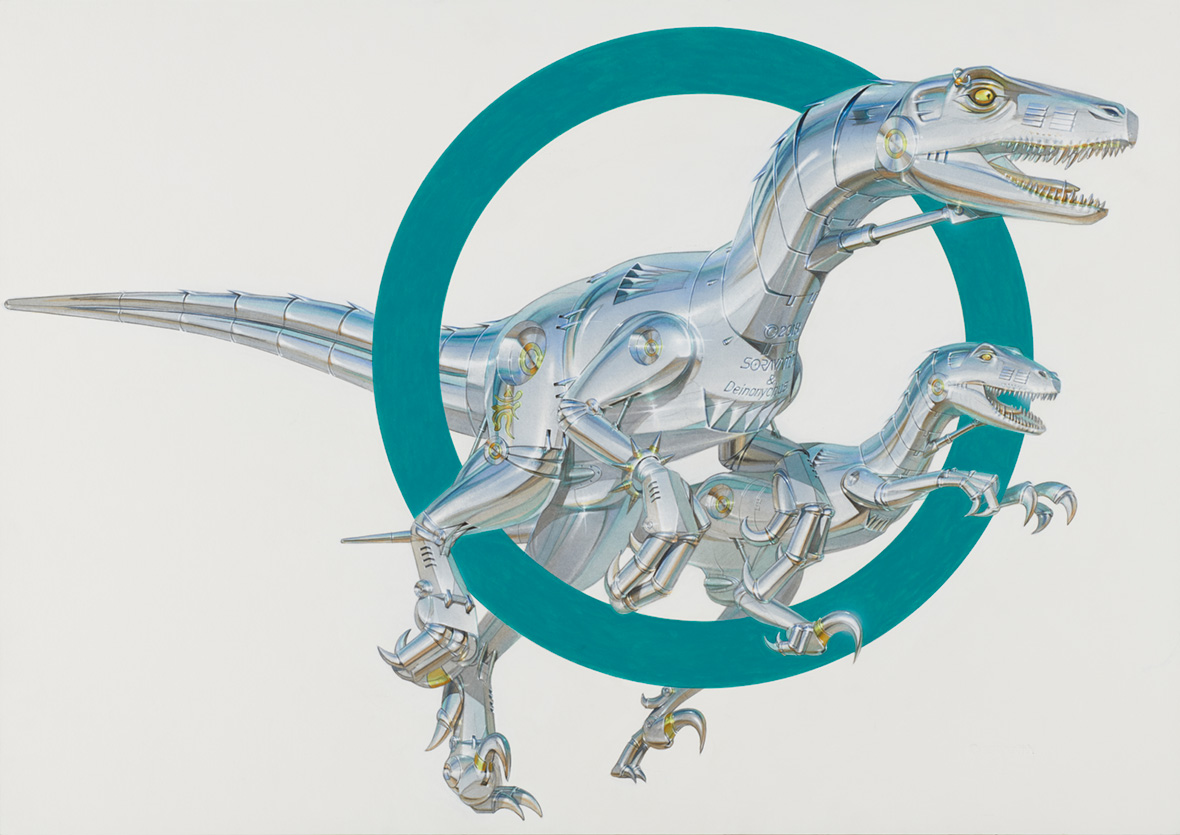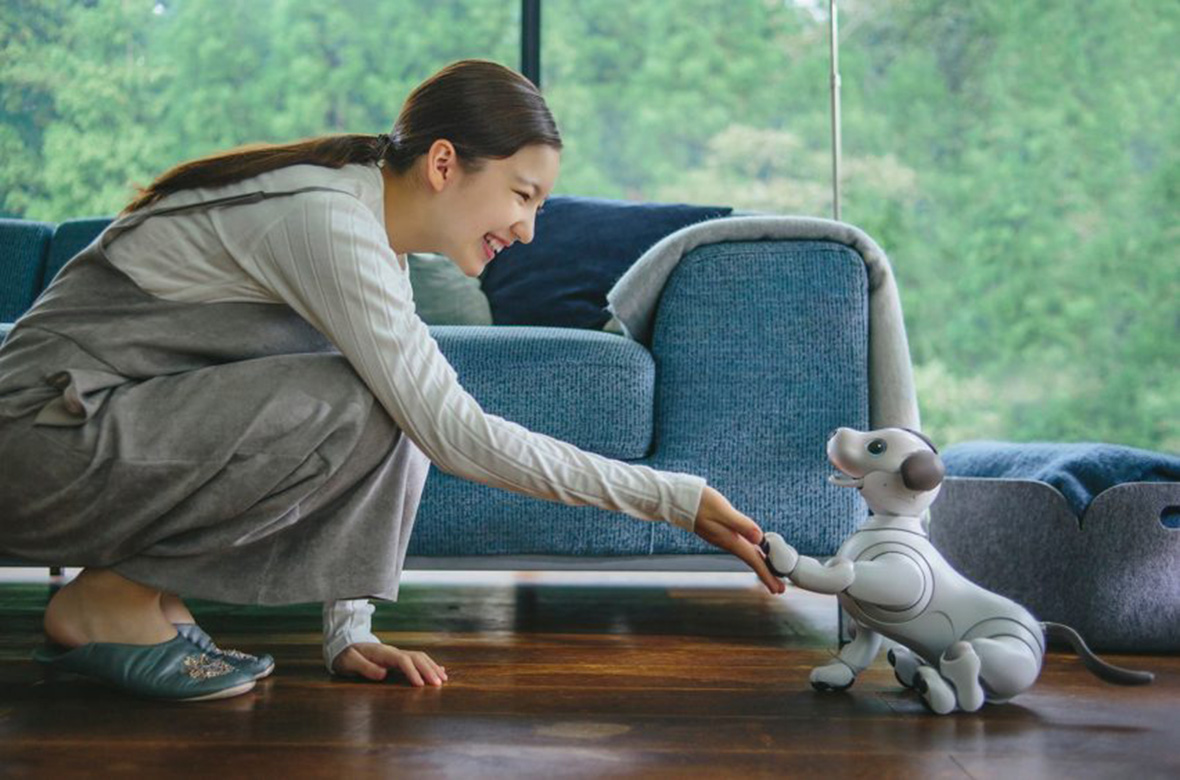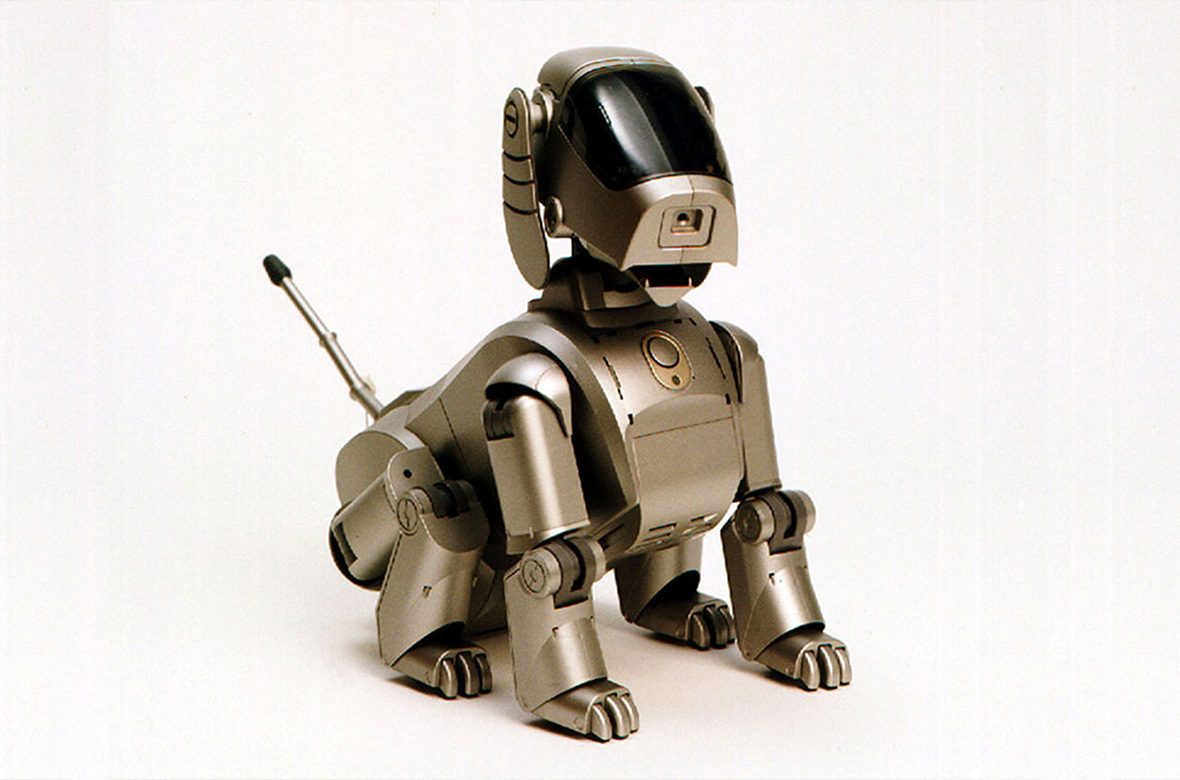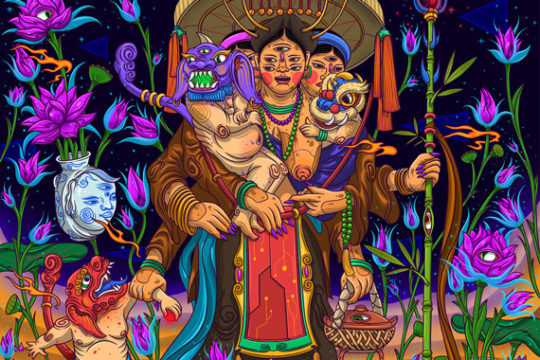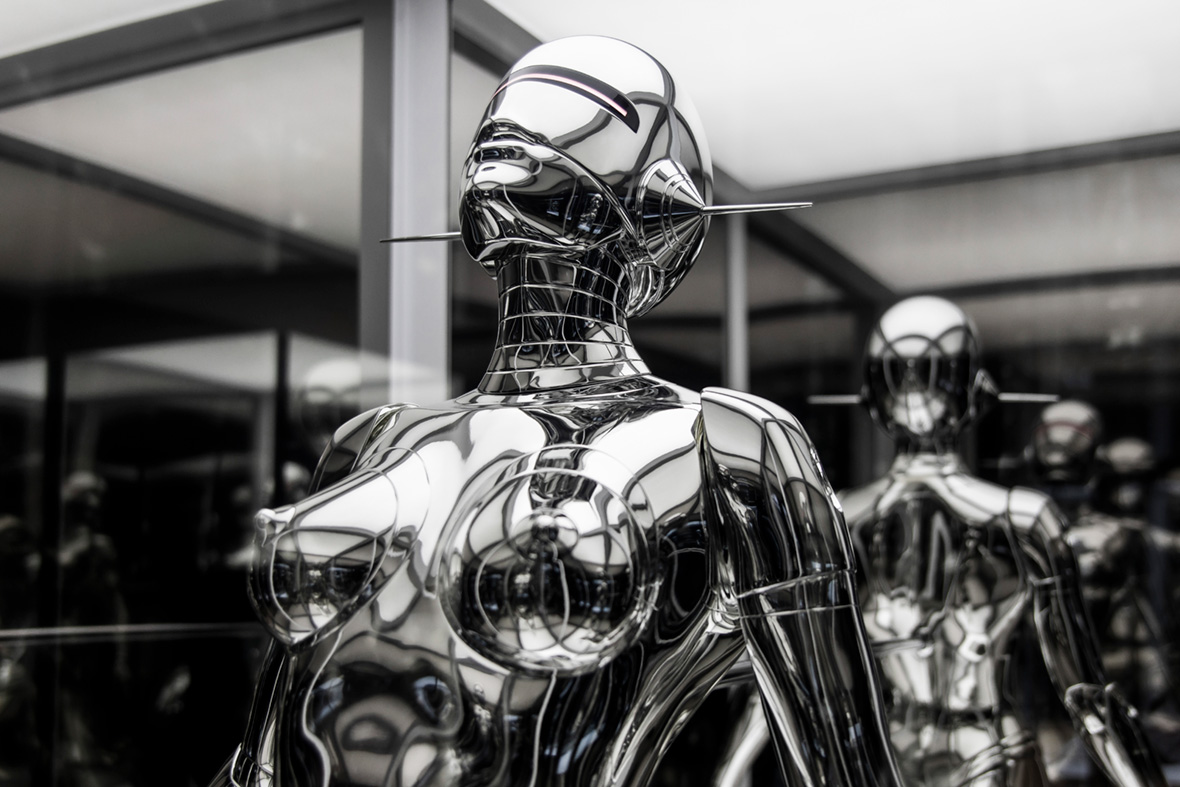
With their metallic skin, Hajime Sorayama‘s hyperrealistic gynoids have earned their place in the 20th-century pop icon hall of fame. They’ve appeared in advertising campaigns, fashion shows, and album covers. The most notable example of the latter is Aerosmith’s Just Push Play, in which a Sorayama gynoid mimics Marilyn Monroe’s subway scene with the wind blowing her dress from below.
空山基所创作的超现实主义机械姬 (Gynoid) 以一袭金属皮肤造就了二十世纪的流行标志,成为广告大片、时装秀和专辑封面的常客。其中最为人熟知的,莫过于美国硬摇滚乐团 Aerosmith 专辑《Just Push Play》封面上的造型,空山基所画的机械姬效仿玛丽 · 莲梦露,摆出双手遮挡裙子的经典姿势。
Sorayama is an influential figure in the development of notions of futurism and mechanical aesthetics. He was one of the first to inaugurate the idea of a robot as a sensual being. Still, Sorayama holds his characters in much more affectionate esteem than erotic or utilitarian. “They are not sex machines,” he says, categorically. He’s in no way objectifying women.
在未来主义和机械美学发展史上,空山基算得上是举足轻重的人物,也是最早创作情色风格机器人的艺术家之一。空山基拒绝物化女性,他对自己一手打造的角色有着超乎情欲或功利心之外的情感,“她们不是性爱机器,”他斩钉截铁地说道。
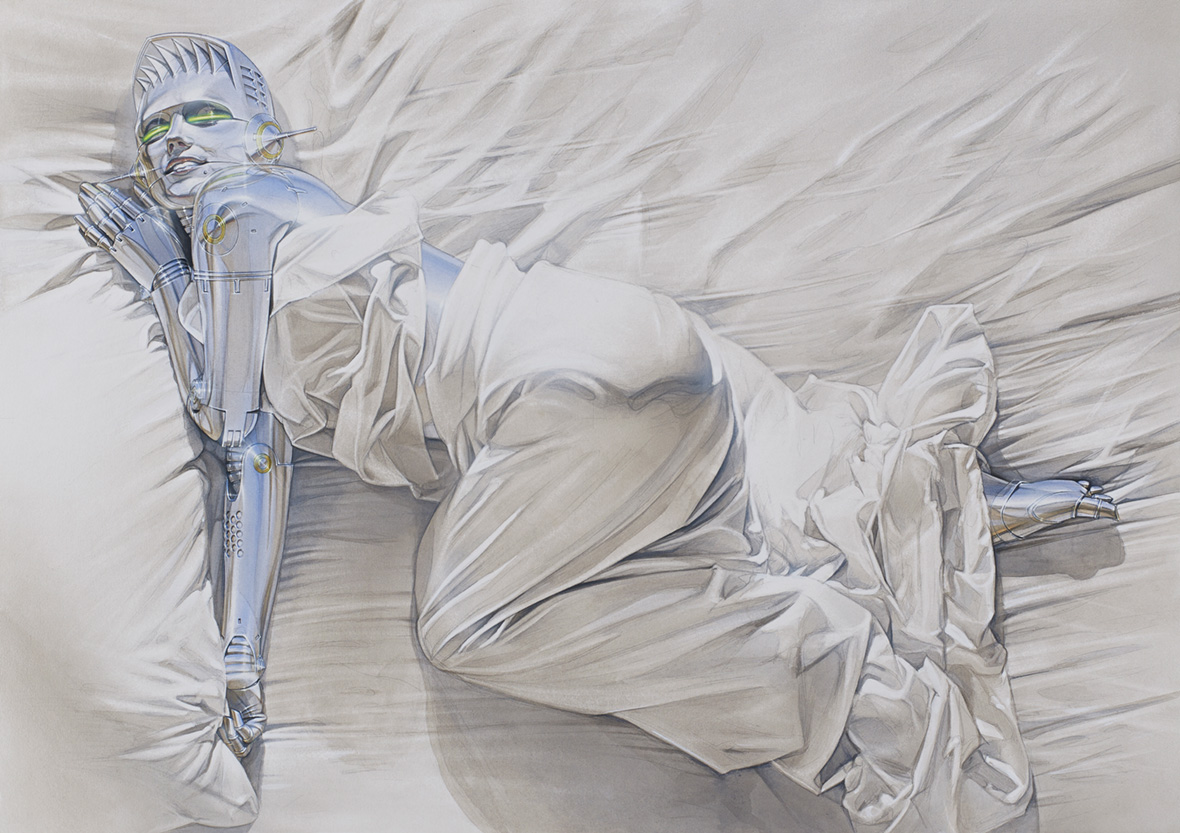
His gynoids are full-grown and full-figured women, and he emphasizes their femininity using the cliches of a sexy female figure. They’re all tall and slender, with hourglass-shaped bodies, perfect teardrop breasts, curvy hips, and long, beautiful legs. He depicts their anatomy with impressive exactitude, a striking effect when juxtaposed with the mechanical characteristics they bear—rivets, joints, bolts, air vents, and a brilliant metallic outer coating.
Other robotic features also appear, such as visor eyes, antenna ears, and serial numbers. Sometimes they bear cryptic messages debossed in their bodies, such as “platinum dream,” “cyber discipline,” “corruptrix,” and “we all got screwed!” The gynoid who bears the latter is pleasing herself with a screw, literally. Sorayama also includes a trademark symbol, his iconic logo, and the manufacturing year in all of them, invariably.
无一例外,这些“金属打造”的机械姬都是身材丰润的成熟女性,空山基按照世俗审美,以性感来标榜她们的身躯。她们大都身形修长,有如沙漏般婀娜身姿,拥有近乎完美的身材。拟人的身体结构,与裸露的机械细节 (铆钉、连接件、螺栓、通风口和锃亮的金属外涂层) 形成了令人惊艳的视觉对比。
像很多科幻电影中常见的机器人一样,机械姬同样拥有护目镜、天线耳朵和序列号标记。有时,她们的身体上还会刻上一些带有象征意味的字符,比如“platinum dream”(白金梦)、“cyber discipline”(网络纪律)、“corruptrix”、“we all got screwed!” 等等。另外,空山基还会在她们身上画上商标符号、他的个人标志以及制造年份。
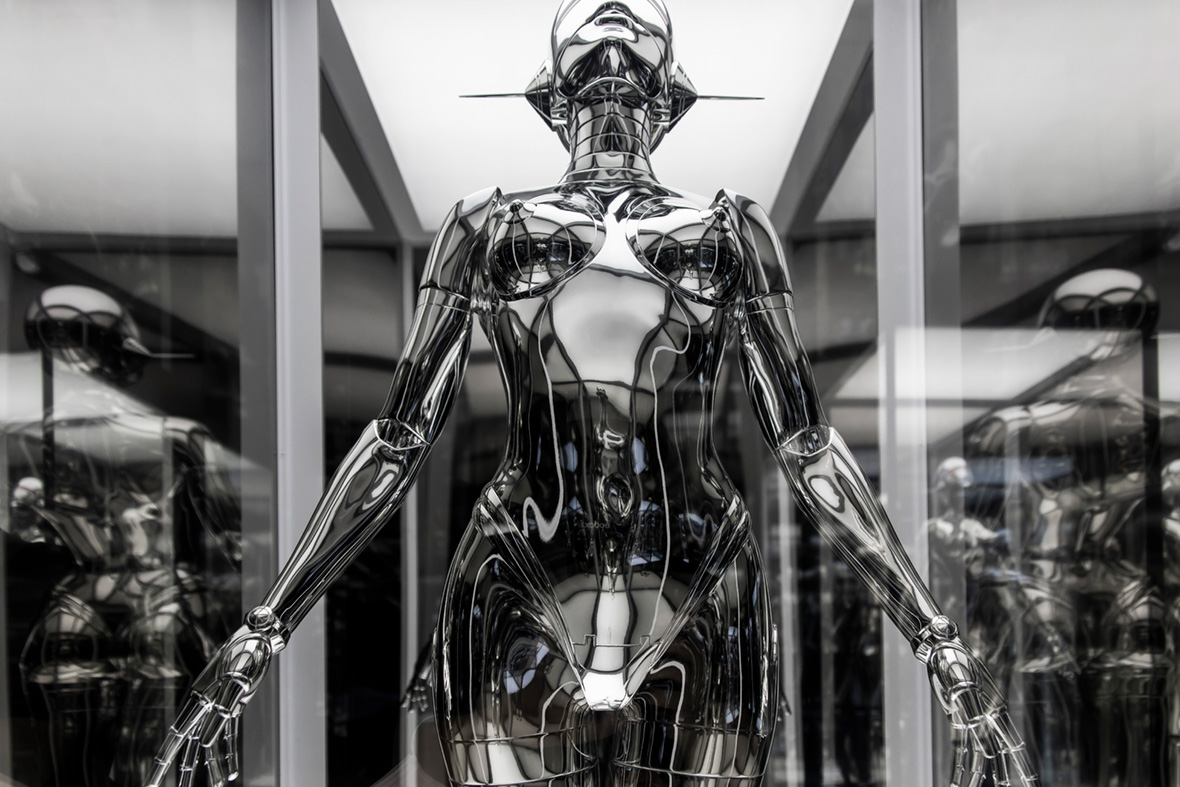
His gynoids seldom wear clothes. Most of the time, they are entirely naked. And even though they are objects, they don’t look objectified. Instead, they appear confident as if they were the ones in control—in control of their sexuality and of whoever or whatever crosses their way. They’re undeniably sensual, and their attitude is as sexy as it is inspiring. “Female fans have told me they want to look like my work when they become robots in the future. That makes me happy,” Sorayama says.
他的机械姬大多数时候都是赤身裸体,她们并无生命,却与被“物化”毫不沾边。相反,她们看起来却像是自信霸气的女王,仿佛牢牢掌握住命运的主动权——掌控着自己的性欲、选择她们身边的任何人或事物。毋庸置疑,她们性感美艳,但同时又释放出一股鼓舞人心的力量。空山基说:“我很开心听到女粉丝告诉我,将来如果她们变成机器人,她们希望自己变成我的作品那样。”
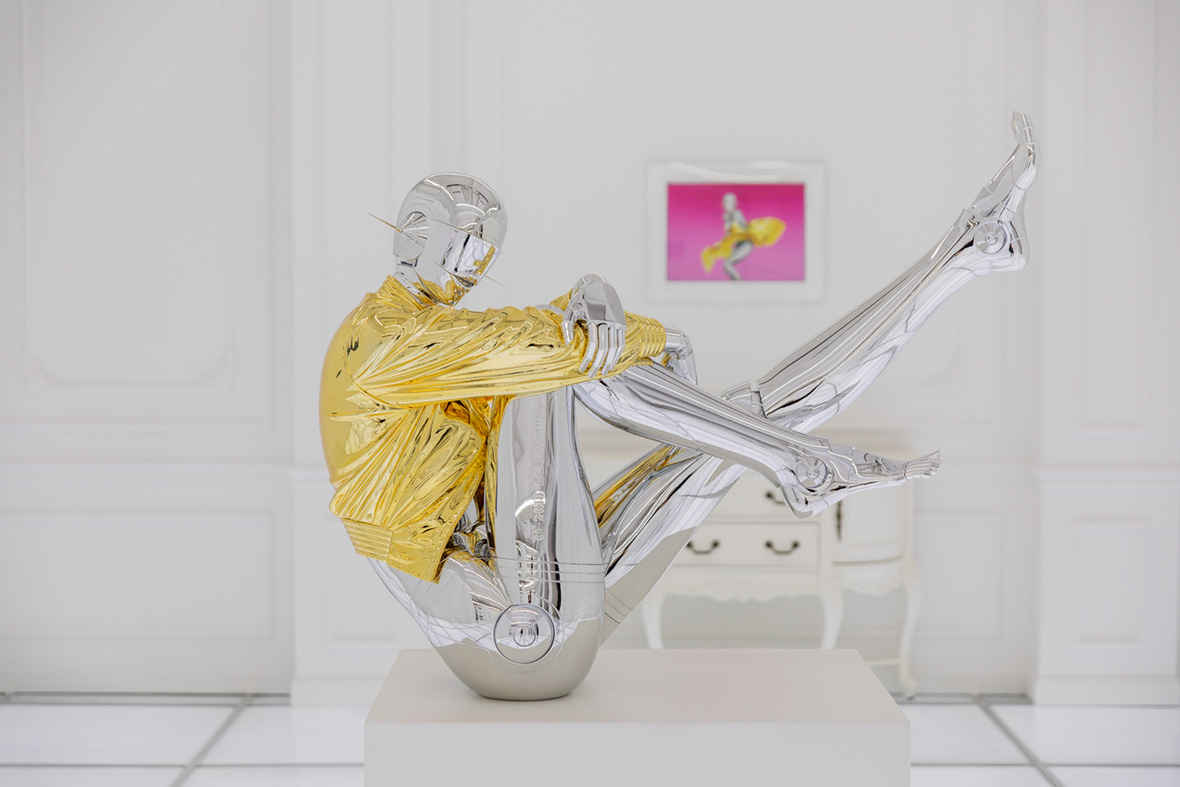
Born in 1947 in Imabari, Sorayama grew up in post-war Japan, a time of nationwide transformation and growing American influence. He began drawing pinup-style women in high school, inspired by the risqué photographs he saw in Playboy. In 1965, he enrolled at Shikoku Gakuin University to study English literature and Ancient Greek. There, he published an illustration magazine titled Pink Journal. But the publication wasn’t well-received by the faculty and students due to its highly sexual content. Not surprising, considering Shikoku Gakuin was a Christian university. While others were attending Mass in the campus’ chapel, Sorayama was pasting erotic art on the walls. It was a matter of time until he got kicked out.
Sorayama then transferred to Tokyo’s Chuo Bijutsu Gakuen to study art, where he graduated in 1969 and landed a job in advertising. “When I started working, I remembered I had been praised for my drawings when I was a child,” he says. “Since I wasn’t good at anything else, I became an illustrator. I admired Da Vinci and Hokusai at the time, but I drew what I liked, and the result is what I am today.”
空山基于 1947 年出生于今治,在战后的日本长大,正值日本进行全国改革和美国影响日益增强的时期。在看了《花花公子》中风格大胆的照片后,他从高中开始手绘海报女郎。1965 年,他进入四国学院大学学习英语文学和古希腊语,期间还出版了一本名为《Pink Journal》(粉红杂志) 的插画杂志。但由于内容过于情色,这本杂志并不受教职员工和学生的欢迎。这也并不奇怪,毕竟四国学院是一所基督教大学。当其他人在学校的小教堂参加弥撒时,空山基却在墙上张贴情色艺术作品。最终,他被学校开除。
空山基随后转入东京中央学院大学学习艺术专业,1969 年毕业后进入了广告行业工作。他说:“我记得那时候大家都称赞我的画画得好,加上我没什么特别擅长的,所以最后选择成为一名插画师。当时我很欣赏达芬奇和葛饰北斋,但我还是按照自己的喜好来画,最终就形成了现在的创作风格。”

In the late 1970s, with an established reputation as a freelance illustrator, a friend asked him to draw a poster for Suntory Whisky. The original idea was for the ad to feature C-3PO, the golden humanoid robot from Star Wars. But facing copyright issues and running on a tight deadline, his friend asked Sorayama to design a replacement. Sorayama’s solution wound up being his first-ever robot artwork, which was a genderless droid with arms and legs as skinny as toothpicks and shiny platinum skin. Inspired by the project, he expanded on the idea and drew a mechanical woman next. “It was the first sexy robot I drew,” he says. His gynoid was born.
In 1983, Sorayama published Sexy Robot, a book compiling his sensual robot drawings up until then. It was an instant hit. They appeared in a clear pinup style, striking poses that accentuated their bodies, like sitting on their knees, fixing their hair with both hands up, or lying on their backs with legs up in the air. It was all very suggestive, and it contrasted with their silvery-white and seemingly cold skin. Such a novelty fascinated the public, and Sorayama quickly became a cult hero.
Pin-Up, a second book, came right after, this time depicting real women with elements of fetishism such as latex and leather. Not long after, he was invited to illustrate the pages of the very magazines he was inspired by—Playboy and Penthouse. In general, Sorayama also borrows from mythical or fictional icons such as Wonder Woman or the goddess Venus. He also draws human-robot hybrids. But through it all, he maintains his signature hyper-realistic pinup style.
到了 1970 年代末,他以自由插画家的身份站稳一席之地后,一位朋友邀请他为三得利威士忌画一幅海报。朋友们最初的想法是在广告中画《星球大战》中的金色人形机器人 C-3PO,但由于版权问题和截稿时间紧迫,朋友只好请空山基重新设计。而空山基所画的这个机器人最终成为了他有史以来的第一个机器人作品。这是一个无性别的机器人,其手臂和双腿细如竹签,外面由闪亮的铂金皮肤包裹。项目激发了他进一步扩展这个视觉概念,随后的一位机器女人,标志着机械姬的正式问世。
1983 年,空山基出版了《Sexy Robot》(性感机器人) 一书,收录了他在那之前所创作的所有性感机器人作品。这本书一经出版便轰动一时。他笔下的机械姬充满强烈的画报女郎风格,充满性暗示的姿势,与她们银白色的冰冷皮肤形成鲜明对比。这种新颖的画风吸引着大众的眼球,空山基也一跃成为备受追捧的插画家。
紧随其后,他又出版了第二本书《Pin-Up》(画报女郎) ,这一次,他加入了乳胶和皮革等恋物癖元素。自那之后,他获邀不断,曾为当初他的启蒙刊物——《花花公子》和《阁楼》(Penthouse) 创作。空山基在创作时也会借鉴神话或虚构角色,如神奇女侠或女神维纳斯。除此之外,他还画许多机械半人,但始终保持了他标志性的超写实画报女郎风格。
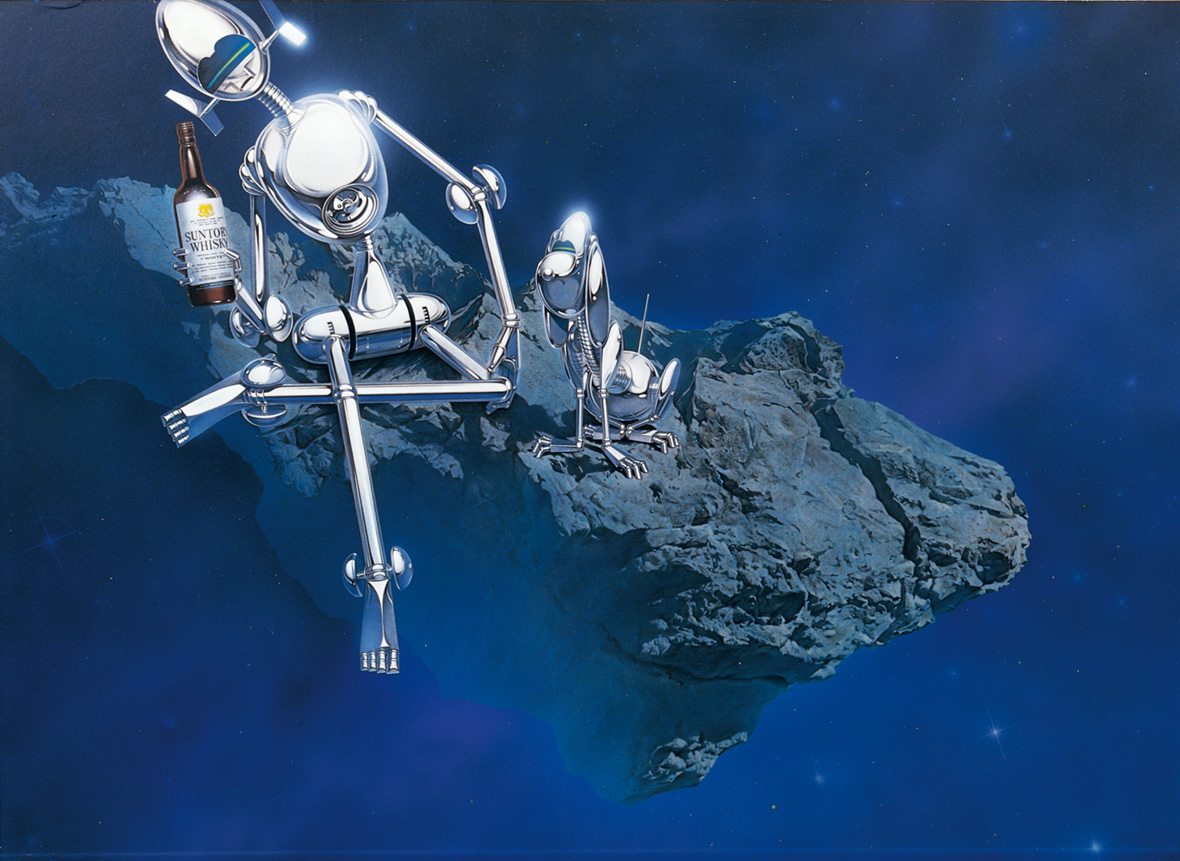
It’s only reasonable to assume that Sorayama would have faced some form of backlash from specific demographics for the salacious nature of his work, especially in Japan, where society can be notably conservative. “Not once,” he denies it. “I never thought of eroticism as a bad thing, and I think that the people who look at my pictures understand exactly what I mean.”
Women were at the very heart of robot depictions. One of the first robots to appear in science fiction—and perhaps the most influential until today—was Maria in Fritz Lang’s Metropolis (1927). Maria has a similar appearance to Sorayama’s robots with her metallic armor, shapely hips, and prominent breasts. However, she’s stiff, walking with no fluid motion or showing emotions on her face. Even if she’s not meant to be sexual, Maria was born from her mad creator’s infatuation with an ex-lover and was supposed to take in her personality and figure.
Another influential robot to appear in science fiction was the HAL 9000 computer from Stanley Kubrick’s 2001: A Space Odyssey (1968). HAL does not resemble a human being in any physical way—he’s merely a fisheye lens with a red dot at its center, more akin to the eye of hell. But he’s human-like in his soothing male voice and his sentience. And that’s the most chilling part. In one of the most memorable scenes, HAL turns on his creators to save himself from being disconnected and to prevent the abortion of his mission.
In such a way, Kubrick inaugurates our underlying fear of artificial intelligence and the notion that machines could also be capable of powerful emotions. 2001 is a film renowned for its artistic and technical excellence, realism, and immersive quality that influenced everything that ensued in science fiction, including George Lucas’ Star Wars, released about a decade later.
当然,空山基这种充满情色风格的作品必然会遭到人群的抗议,尤其在保守的日本。对此,他回应道:“我从不认为情色是一件坏事,我相信看我作品的人能够理解我的用意。”
女性一直是人类构想机器人的核心。德国导演 Fritz Lang 的电影《大都会》(1927) 中的玛丽亚 (Maria) 是最早出现在科幻片中的机器人之一,而且可以说是迄今为止影响最深远的机器人。玛丽亚的外表与空山基的机械姬相似,都披着金属盔甲,有着丰润的身段。但她举止僵硬,行走动作并不流畅,脸上也不会表露任何情绪。虽然玛丽亚没有任何情色的意味,但她的创作者在设计玛丽亚时是以他的前任情人为原型的,并参照了她的个性与身材。
另一个科幻影片中的著名机器人是斯坦利·库布里克 (Stanley Kubrick) 的《2001太空漫游》(1968) 中的超级计算机 HAL 9000。在外观上,HAL 与人类毫无联系,他只是一个鱼眼镜头。但他也有人性一面——温柔的男性声音和情感感知力,这恰恰是最令人不寒而栗的地方。在影片最令人难忘的场景之一,为了避免自己被断开网络,HAL 试图欺骗他的发明者,以避免他的任务流产。
库布里克以这种方式揭开了人类对人工智能的潜在恐惧,让人们意识到,机器也可以产生强烈的情感,也就是人们常常提到的”恐怖谷”概念。《2001太空漫游》拥有一流的艺术和技术效果、现实主义和身临其境氛围,并深深影响了其后的科幻影片,包括大约乔治·卢卡斯 (George Lucas) 在大概 10 年后执导的影片《星球大战》。
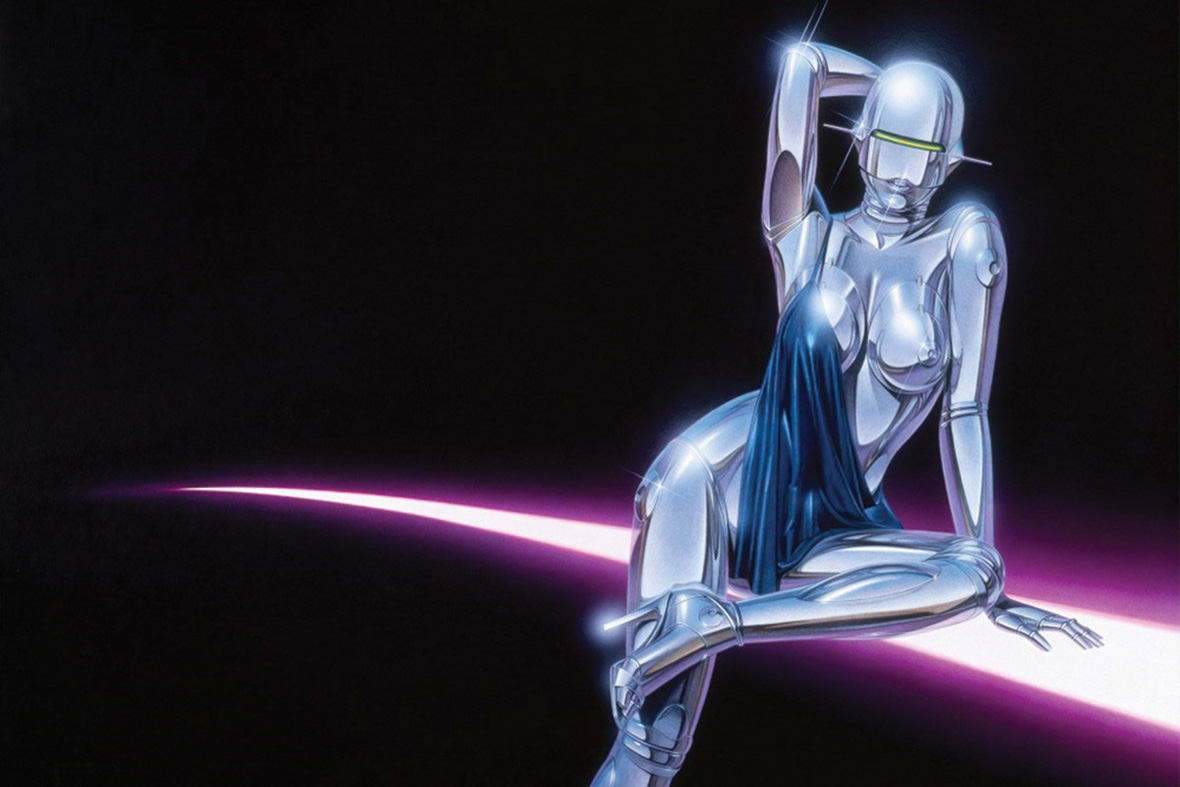
Lucas, however, presents his robots, RDD2 and C-3PO, as much more sympathetic characters and as a comic relief duo in the plot. Interestingly, the design of C-3PO was largely inspired by Metropolis‘ Maria. Star Wars is also influenced by Japanese culture, notably Akira Kurosawa’s films and Samurai philosophy. Its plot is deeply ingrained with mythological motifs, and, as Lucas himself said, it tells an “old myth in a new way” dealing with contemporary issues. To him, precisely for this reason, the saga gained so much resonance.
Sorayama drew his first pin-up gynoids amidst and because of the Star Wars craze of the late 1970s, and he embedded them with the same mythical quality as the film. Admittedly, the traces of fetishism he embeds in his drawings are less of a sexual nature than they are a way of idealizing women. His characters exude powerful femininity, and appear as unattainable goddesses, liberated from patriarchy. And that’s the impression he has of pin-ups from a young age, anyway. “(…) In our day, these pin-ups were like goddesses,” Sorayama said in a 2012 interview. “I guess I could describe it as my own goddess cult.”
Sorayama also sees a woman’s birth-giving capacity as a force to be reckoned with. “All humans are born from a woman and grow up breastfeeding. That’s why all men are mama’s boys,” he jokes. But then he adds in a more serious tone that women “are the source of life and the creators.” He expressed this fascination in the way he depicts the anatomy of the female body, with large hips, tender breasts—perfectly sketched to conceive and nurture a child.
然而,卢卡斯在影片中把机器人 RDD2 和 C-3PO 塑造成更讨喜的角色,并作为情节的喜剧元素。有趣的是,C-3PO 的设计很大程度上受到《大都会》机器人玛丽亚的启发。《星球大战》也受到日本文化的影响,尤其是黑泽明的电影和武士哲学。影片的故事情节糅合了各种神话元素,正如卢卡斯本人所说,这部影片是“以新的方式来讲述旧的神话”,探讨当代的问题。他也认为,正因如此,这系列的电影才获得了如此多的共鸣。
在 1970 年代末的星球大战风靡全球时,空山基创作了他的第一个性感机械姬,并和电影一样,为机械姬加入了神话的元素。诚然,他画中的恋物癖元素与其说是与性欲有关,倒不如说是一种理想化女性的方式。他笔下的角色散发出强烈的女性气质,以高不可攀的女神形象出现,摆脱父权体制的枷锁。而这其实也是他从小对画报女郎的印象。在 2012 年的一次采访中,空山基曾说:“……在我们那个时代,画报女郎就像女神一样。我想这可能也是我个人的女神崇拜。”
另外,空山基将女性的生育能力视为不可忽视的力量。“所有人都是由女性孕育的,接受母乳喂养长大,所以所有男人都是‘妈宝男’,”他开玩笑道,但随后他又一脸正色地补充道,女性“是生命的源泉和创造者”。他的这种迷恋也体现在他对女性身体的描绘上——丰满的臀部和柔软的乳房,勾勒出孕育孩子的理想身材。

In a recent solo show at HOW Museum in Shanghai, Sorayama presented several of his pieces since he began drawing robots in the 1970s. The exhibition’s title, “Metropolis,” was a tribute to the homonymous film and Maria, who can be seen as a grandmother of sorts to his own character. In a piece from 2017, Sorayama gives the name of Maria to his gynoid and places her against one of Metropolis’ most famous plate shots, the vertigo-inducing cityscape intersected by roadway systems and airplanes, dominated by Lang’s new tower of Babel.
A highlight of the show was the collection of recently constructed life-size sculptures made of materials such as fiberglass, aluminum, and iron. Not constrained by the properties of the materials, Sorayama transferred the curvaceous and seemingly flexible characteristics of his gynoids into their 3D form seamlessly, bringing his vision to life as a tangible replica of his drawings. The way light and reflections play with their metallic surface is also remarkably similar to his illustrations, emphasizing his mastery of realism.
The display also included a large T-Rex sculpture and a variety of drawings of dinosaurs with the same robotic appearance as his women. When asked before why he likes dinosaurs, Sorayama merely laughed and replied in his typical humor, “I don’t know, I just do.” It’s all ambiguous, but dinosaurs are always associated with the past, and when juxtaposed with the advanced technology of robots, they could signify the confluence of two extremes—past and future.
在最近于上海昊美术馆举办的个展中,空山基展示了他自 1970 年代开始创作的几幅机器人作品。展览标题“大都会” (Metropolis) 也是对同名电影和玛丽亚的致敬,而玛丽亚也可以说是他所创作的机械姬角色的蓝本。在一幅创作于 2017 年的作品中,空山基为机械姬命名“玛丽亚”,背景是《大都会》最著名的场面之一:公路交通与飞机交汇成令人眩晕的城市景观,由 Fritz Lang 创作的全新巴别塔矗立于其中。
这次展览的一大亮点是一系列真人大小的雕塑装置,由玻璃纤维、铝和铁等材料制成。空山基摆脱了材料特性的限制,将他笔下机械姬的优美线条与灵活动作,移植于 3D 雕塑,将他的构想化为真实可触的装置。金属表面的光线与反射效果也与插图近乎一致,彰显了他对现实主义风格的自如运用。
这次展览还包括一个大型霸王龙雕塑和各类恐龙画作,这些恐龙和机械姬一样有着机器人的外观。空山基在之前被问到为什么喜欢恐龙时,都只是笑笑,用他一贯的幽默回答:“不知道,就是喜欢。”虽然他只给了模棱两可的回答,但恐龙通常都是与过去联系在一起,而现在与先进的机器人的结合,或许寓意着过去与未来的两极交汇。
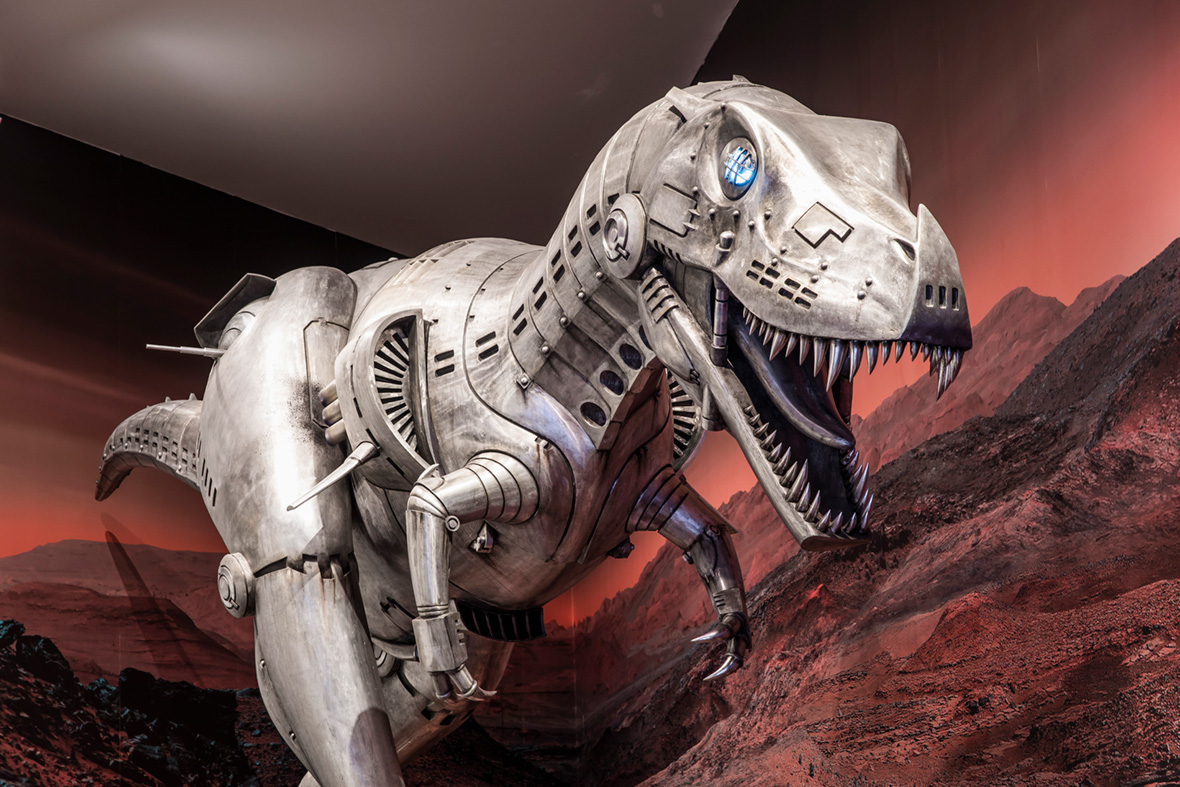
The most striking part of the exhibition was the recreation of the hotel room in 2001: A Space Odyssey, where some of Sorayama’s sculptures were shown, including his homage to Maria. The playful parallel with one of the most cryptic movies in cinema history highlights the same quality in Sorayama’s oeuvre. It also provides an immersive spectacle of what defined visions of the future in the 1970s and 80s, a formative period for his growth as an artist.
展览中最瞩目之处莫过于重现了《2001太空漫游》影片中的酒店房间场景。与这部电影史上最神秘的电影之一的有趣跨界,让观众感受 1970 和 1980 年代人们对未来的奇妙愿景,而这也是他作为艺术家,形成个人风格的时期。
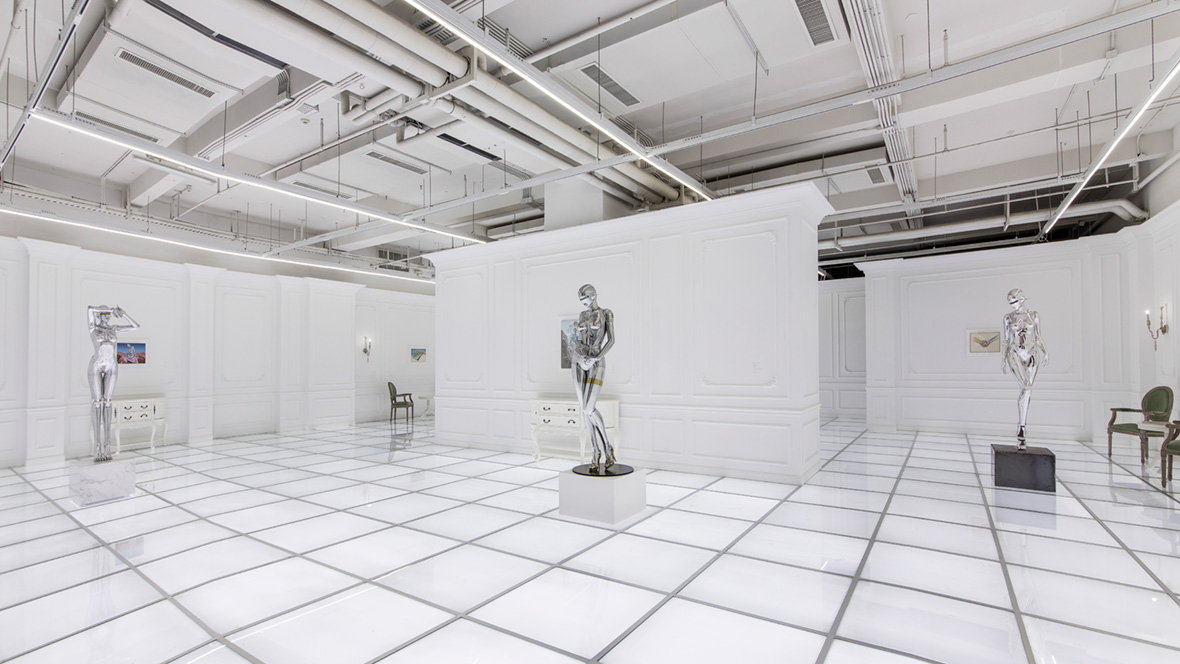
In the late 1980s, Sorayama drew a gynoid to star in the Japanese animated film The Humanoid (1986), and it caught the eye of Hollywood producers. In the 1990s, he consulted and collaborated with Western sci-fi blockbusters such as Timecop and Space Truckers. It was an extraordinary time for the genre. The evolution of computer graphics and special-effects technology made new ideas possible. Fast forward to 2013, George Lucas himself reached out to Sorayama for a contribution to the book Star Wars Concept. Sorayama drew a hyper-sexualized robot called Betty Droid, later included in the television animated series Clone Wars.
But his work in Hollywood hasn’t dampened his criticisms of the film industry. “Movies have indeed become a gigantic industry, and the benefits of this are that we have made great science fiction movies,” he says. “But I think there are also many negative effects, such as the worshipping of money.” Sorayama is also unsure about the future of the sci-fi genre once technology completely dominates our lives outside fiction. “Science-fiction movies were attractive when futuristic technology was still far away, but I don’t know if it will remain this way in the future.”
1980 年代后期,空山基为日本动画电影《人形机器人》(1986) 创作了机械姬角色,成功引起了好莱坞制片人的注意。1990 年代,他参与了《时空特警》(Timecop) 和《星河叛变》(Space Truckers) 等西方科幻大片的合作。当时也正值科幻片的鼎盛时期,电脑图形和特效技术的发展使各种新颖创意和构思成为现实。时间快进到 2013 年,乔治·卢卡斯亲自找到空山基,希望他为《Star Wars Concept》一书创作插画。空山基画了一个名为 Betty Droid 的超级性感机器人,该角色后来还沿用到了电视动画系列《克隆人战争》(Clone Wars) 中。
虽然有合作,但对电影行业的批评他也直言不讳:“电影确实已经成为一个庞大的产业,好处是我们可以制作出色的科幻电影,但也带来了很多负面影响,比如人们开始变得拜金。”除此之外,空山基担心,当科技的发展已经超出了人们的想象,科幻电影的未来该何去何从。“在未来科技还很遥远的时候,科幻电影对人们来说充满吸引力,但我不知道未来是否还会如此。”
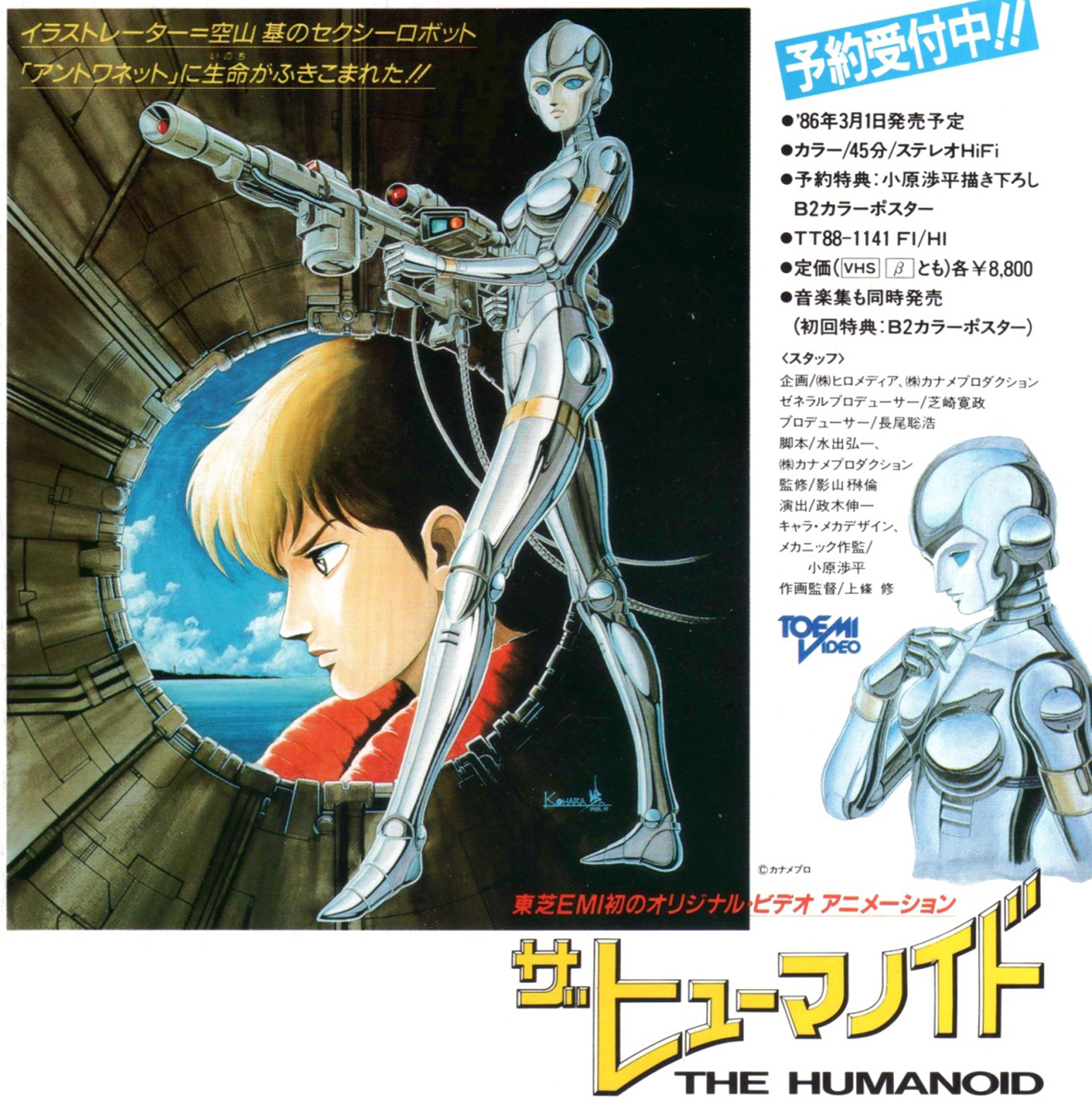
Sorayama has also been responsible for bringing futuristic technology into the real world. In 1998, Toshitada Doi, the head of Sony’s Digital Creatures Lab, invited him to design the appearance of the first consumer model of Aibo, the world’s first AI robot-dog. Sony had been experimenting with animal robots for quite some time by then, but they couldn’t get the visual design right until Sorayama came in. “I drew a rough design and showed it to Mr. Doi, and he used it at once,” Sorayama remembers.
Even in its first generation, Aibo was a remarkable robot able to interact with its environment and learn. In the late 1990s and early 2000s, it represented a vision of what was to come. People imagined a future with robot pets at home, where they didn’t have to worry about feeding them or picking up poo. It didn’t happen, or at least it didn’t go mainstream. But that’s not to say the concept failed. The fourth-generation model was released in Japan in 2018, almost twenty years after the first model. Aibo captivated his niche, and what’s exceptional is that its owners truly bond with it. They name it, pat it, and even miss it when they’re apart. Even though it’s a machine, Aibo drives genuine emotions and smiles.
Japan is known for being a robot-loving country. Besides Aibo, the country was the birthplace of many other world-famous robots. Some say it’s because the cultural acceptance of robots in Japan is higher than anywhere else in the world. While in the West, for instance, robots were seen only as machines, in Japan, they were first defined as controllable artificial humans. They’ve also been present in the country’s popular culture for a long time, as we can see with Astro Boy and many other likable robots that frequently appear in Japanese anime.
Nowadays, it’s common to find robots performing various services in day-to-day life in Japan, such as in office buildings, banks, and restaurants as security guards, receptionists, and even waitresses. There is even a robot hotel in Nagasaki, fully automated, even if more for gimmicky purposes than anything else. Robots are also commonly being used as companions in nursing homes to combat loneliness, and there was at least one incident of a Japanese man getting married to an AI holographic anime character. All this leads to a more positive attitude regarding robots, which diverts from the notion that they are here to take over humans.
But, at least for humanoid robots, Sorayama thinks there’s still a long way to go, and he says that based on his observations during a recent visit to a robot factory. “They still can’t walk gracefully on two legs or move with delicate movements as humans do,” he says, and he realizes the task is complex. “Humans are miraculous creatures, made of highly complex mechanisms.”
空山基也曾参与现实世界的未来科技发展。1998 年,索尼数字生物实验室负责人土井利忠 (Toshitada Doi) 邀请他设计了世界上第一只人工智能机器狗 Aibo 的外观。索尼当时已经对动物机器人进行了一段时间的测试,但他们一直没有找到合适的视觉设计,直到空山基的加入。“我当时画了一个大概的设计图给土井先生看,他马上就采用了,”空山回忆道。
第一代 Aibo 已经是很了不起的机器人,能够与环境互动并学习。在 1990 年代末和 2000 年代初,这只机器狗代表了人们对未来的憧憬:一只在家里有机器人宠物,不用费心喂养或处理便便。但这个憧憬最终未能成为现实,或者至少说未能成为主流。但这并不代表这个概念失败了。第四代 Aibo 于 2018 年在日本发布,距第一代 Aibo 推出已经过了 20 年。这一次,Aibo 获得了这个小众市场的青睐,最让人惊喜的是,它的主人可以真正与它建立联系,给它起名字,抚摸它,甚至在分开的时候会想念它。这一代的 Aibo 虽然是机器,但却能激发真正的情感,带来欢乐。
日本是一个热爱机器人的国家。除了 Aibo,日本还发明了许多世界著名的机器人。有人认为这是因为日本对机器人的文化接受度高于其他地方。例如,在西方国家,人们只把机器人视为一种机器,而在日本,它们从一开始就被定义为可控的“人造生命体”,其很久之前就已经出现在日本的流行文化中,譬如铁臂阿童木和机器猫等等。
如今,在日本的日常生活中,经常可以看到机器人从事各类服务,例如在写字楼、银行和餐厅中担任保安、接待员等等。在长崎甚至还有一家完全自动化的机器人酒店,虽然大部分仍然是以制造噱头为主。除此之外,疗养院也经常用机器人来提供陪伴,帮助人们对抗孤独,日本男人和 AI 全息动漫角色结婚的事件也发生了不止一次。所有这些都导致人们对机器人持有好感,而不会想到它们或许会取代人类这种想法。
但空山基认为,对于人形机器人来说,还有很长的路要走,他说:“它们仍然无法像人类那样用两条腿自然流畅地行走或做出微妙的动作。但毕竟人类是神奇的生物,由高度复杂的机制构成。”
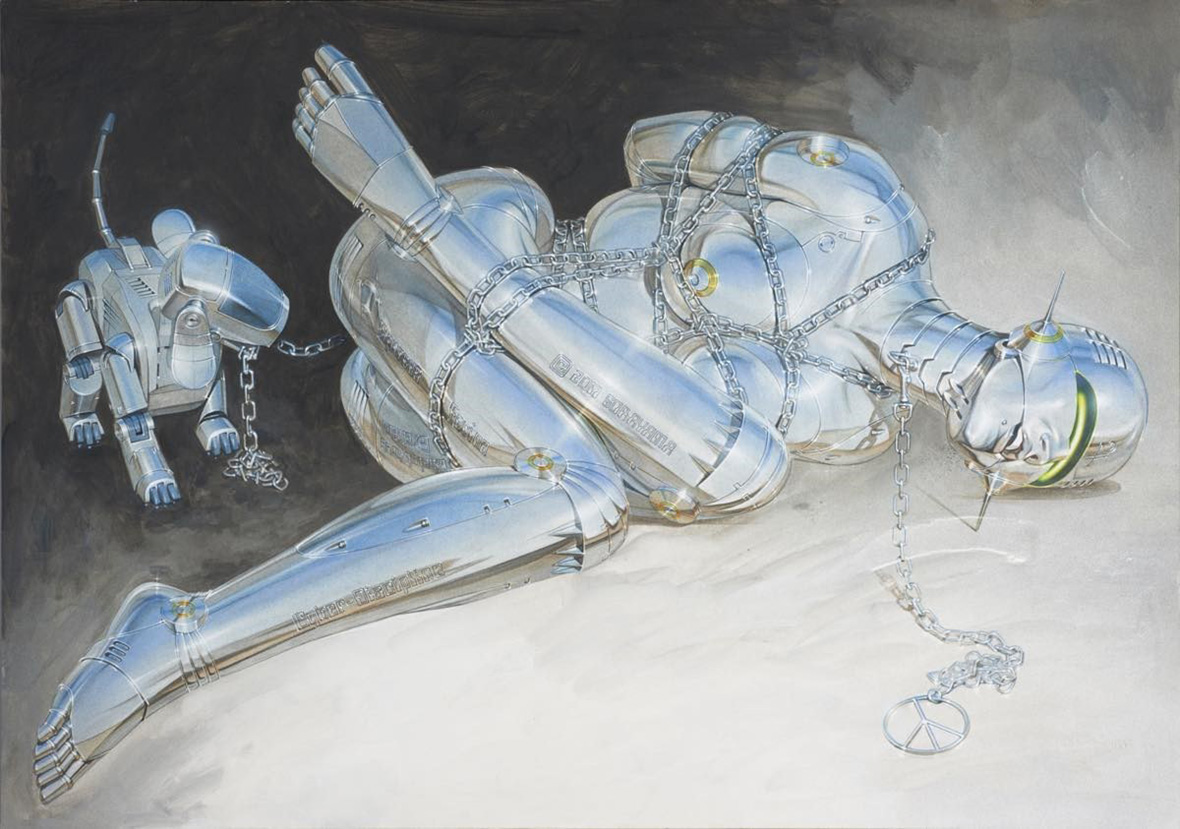
Interestingly, despite his gynoids’ goddess-like characteristics and high-tech appearance, Sorayama simultaneously and paradoxically thinks of them as humans. The technological element appears less meaningful to him, more a result of an aesthetic preference than an essential quality. “My work takes a life form based on my aesthetic sense,” he says. “You can think of [the gynoids] as human beings with metallic skin. That’s why they have sexual desires and other physiological needs.”
Even in his creative process, his interest in the evolution of technology remains on an aesthetic level. “Even though tools have become more convenient, my creative process in itself hasn’t changed,” he says. In his studio, cluttered with many references, memorabilia, studies, and, naturally, erotic art, Sorayama uses the same manual methods he used when he began drawing. Together with Harumi Yamaguchi, he’s regarded as a master of the airbrush technique, employing it for soft gradients. And he works with two different erasers to create his characteristics glows, highlights, and reflections. An untrained eye could easily mistake such effects for digital work.
有趣的是,虽然空山基创作的机械姬拥有女神外表和高科技外观,但同时他又矛盾地将她们视为人类。这些科技元素似乎对他来说没有太大的意义,更多的是一种审美偏好,而不是重要的因素。他说:“我的作品是以我的审美为基础打造的生命形体。你可以把’机械姬’当作是披着金属皮肤的人类,她们也有性欲和其他生理需求。”
在创作的过程中,他对科技的运用也只停留在审美层面。他说:“尽管创作的工具越来越方便,但我的创作过程本身并没有什么变化。”他如今仍然和最初一样坚持手绘创作。他与山口晴美 (Harumi Yamaguchi) 都是公认的喷绘技术大师,用喷枪打造柔和与渐变的效果。机械姬身上反光、高光的效果,均来自空山基两块不同材质橡皮擦的运用,很像是电脑合成。
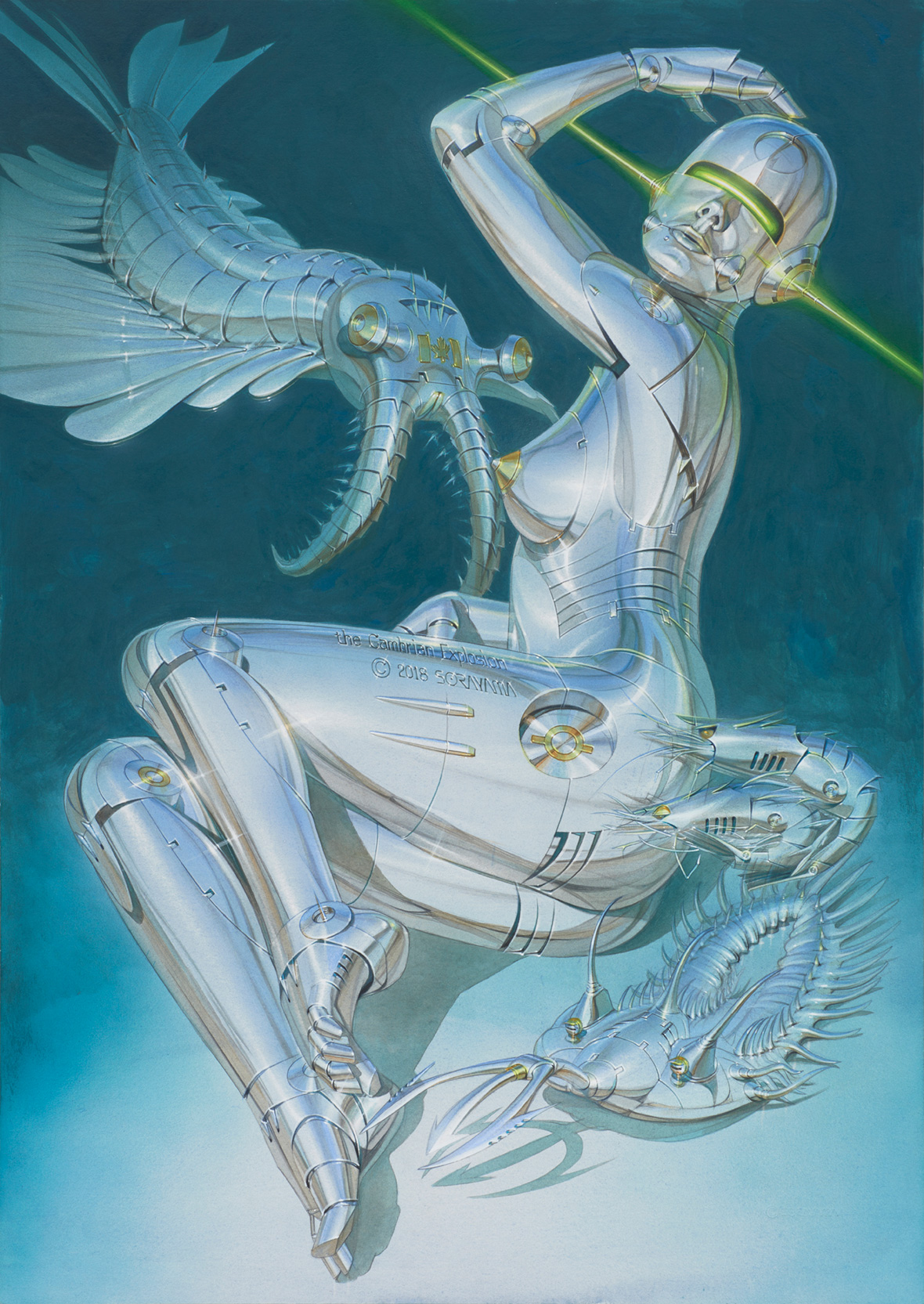
Still, Sorayama is not oblivious to the advancements of technology in the domain of art. He recently ventured into the metaverse with NFT art of his own, reproducing a pair of animated robot-sharks taken out of his Aquatic series. He offered them to the public at affordable prices to make them accessible and, in a way, challenge the speculative bubble that ensued with the rise of NFTs. At heart, he’s not looking for a quick cash grab, unlike many artists who are charging exorbitant prices for their NFT work. “I aim for my work to be an inscription of a perpetual futuristic history,” he says.
It’s indeed as a piece of futuristic history that Sorayama’s gynoids live in our collective consciousness. Their retrofuturistic allure throws us back to a future that never was. And yet, a closer look reveals they’re still connected to the world of now. Blurring the lines between humans and machines, they shed light on our complicated relationship with technology and bend our notions of desire, sex, and gender. When asked about his thoughts on the future, Sorayama’s usual irreverence comes into play. “I don’t know. Maybe a woman will take over the world, and all men will be slaves. It’s already like that in my house,” he laughs.
虽说如此,空山基并没有刻意忽略艺术领域的科技发展。最近,他推出了自己的 NFT 艺术,重现了他的《Aquatic》(水生物) 系列中一对机器人鲨鱼的作品、并大胆进军全新的“元宇宙”领域。他以亲民的价格向公众出售这些作品,这在某种程度上也是在挑战 NFT 兴起以来所产生的经济泡沫。他不打算像许多艺术家那样为自己的 NFT 作品收取高昂价格,他的初衷绝不在于圈钱,“我的目标是让我的作品成为未来历史的永恒记录,”他说道。
毋庸置疑,空山基的机械姬已成为我们对于未来构想的一种集体记忆。她们的复古未来主义魅力将我们拉回一个从未存在过的世界。然而,细看之下就会发现,她们仍然与现在的世界相连——既模糊了人类与机器之间的界限、揭示人类与科技的复杂关系,又试着改变我们对欲望、性和性别的观念。当被问及对未来的想法时,空山基恢复了一贯的玩笑式的神情,他说道:“我也不知道。也许女人会主宰着整个世界,让所有的男人成为奴隶。我家里现在就是这样。”
Like our stories? Follow us on Facebook and Instagram.
Website: www.sorayama.jp
Instagram: @hajimesorayamaofficial
Contributors: Tomas Pinheiro, Lucas Tinoco
Chinese Translation: Olivia Li
Images Courtesy of Hajime Sorayama, NANZUKA, & HOW Museum
网站: www.sorayama.jp
Instagram: @hajimesorayamaofficial
供稿人: Tomas Pinheiro, Lucas Tinoco
英译中: Olivia Li
图片由 Hajime Sorayama、NANZUKA 与 HOW Museum 提供

